Year
2012
20 entries in this year | view all years
Christmas Spirit
Posted December 2012 in Childhood Photography, New Additions, Significant Photographs
 Detail: 1895: "LA VIERGE A L’ENFANT", (The Virgin and Child) Baron Adolph de Meyer: hand-pulled photogravure from: Bulletin du Photo-Club de Paris: December, 1896: 17.1 x 12.1 cm | 27.2 x 19.7 cm: PhotoSeed Archive
Detail: 1895: "LA VIERGE A L’ENFANT", (The Virgin and Child) Baron Adolph de Meyer: hand-pulled photogravure from: Bulletin du Photo-Club de Paris: December, 1896: 17.1 x 12.1 cm | 27.2 x 19.7 cm: PhotoSeed ArchiveSuddenly
Posted December 2012 in Childhood Photography
Non-sensical is how a childhood friend of mine described Friday’s shooting rampage at Sandy Hook Elementary School in Newtown, Connecticut which claimed the lives of 26 souls: 20 first-grade students and another six, educators who worked there.
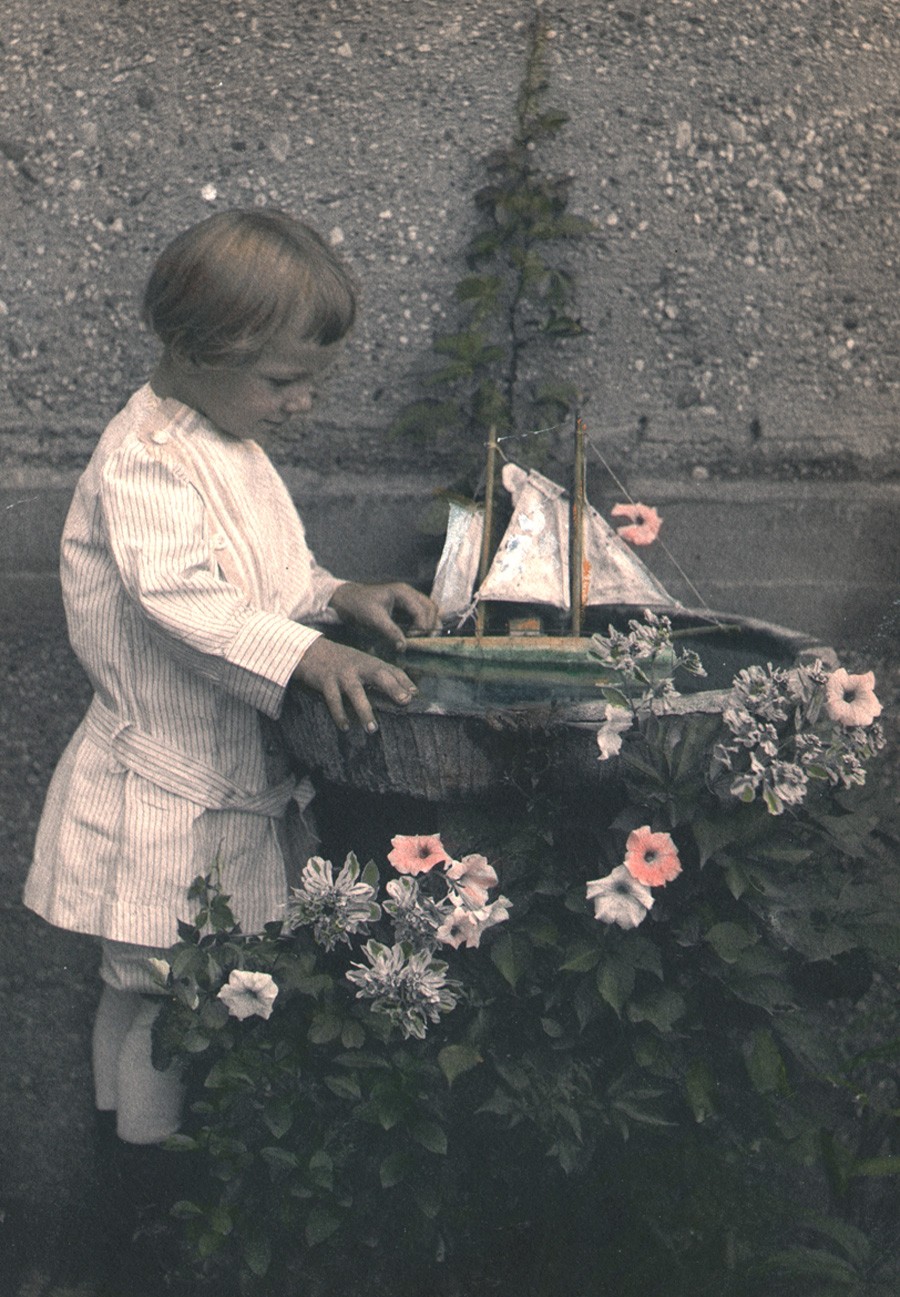 Detail: 1913: C.M. Shipman: American: his son, Mulford Cressey Shipman, (1910-1921) who died suddenly according to his obituary, plays with his toy sailboat in a birdbath: vintage platinum print with hand-coloring from memorial album: image: 21.8 x 15.2 cm: album support: 26.3 x 30.5 cm: from: PhotoSeed Archive
Detail: 1913: C.M. Shipman: American: his son, Mulford Cressey Shipman, (1910-1921) who died suddenly according to his obituary, plays with his toy sailboat in a birdbath: vintage platinum print with hand-coloring from memorial album: image: 21.8 x 15.2 cm: album support: 26.3 x 30.5 cm: from: PhotoSeed Archive
He had come to know the school’s psychologist, a victim of the shooting who occasionally gave my friend rides to school because of proximity of residence. The news was equally devastating for me, because some of my happiest memories as a child and teen were spent in Newtown, a place very close to where I grew up. I often went to the Edmond Town Hall movie theater there with my dad and brother. It cost only $1.00 to get in back in the 70’s and 80’s and I’m sure it was front page news in the local newspaper—the wonderfully named Newtown Bee— when the price shot up to the current admission of $2.00.
The town landmark, however, is the large flagpole dating to America’s first centennial in 1876 just down the street from the theater. Along with picture-perfect 18th century colonial homes flanking main street leading up to it, this beacon with Old Glory now at half-mast is their version of Grand Central’s famous clock. With great restraint, foresight, and deliberate zoning keeping the fast-food joints far away, the town fathers and mothers have thankfully preserved their past and home, founded in 1705 and incorporated in 1711. Dating to before our Republic’s founding, it’s possible an American president has been through this neck of the woods before; perhaps just not in recent memory. Besides standing in solidarity with Newtown’s surviving families and helping to bring closure to our national collective grief from this most incomprehensible tragedy, let’s hope his visit there tonight spurs definite action and realistic solutions to our long-running conversation on gun regulation. We owe our children nothing less.
Famous Kodak Girl?
Posted December 2012 in Advertising, Fashion Photography
Recognize the face? A teen model aiming her Kodak in a sheep field? If yes, please do tell. With her mystery my acknowledgment, I can say without hesitation it’s a snap getting sucked into the world of early Kodak advertising.
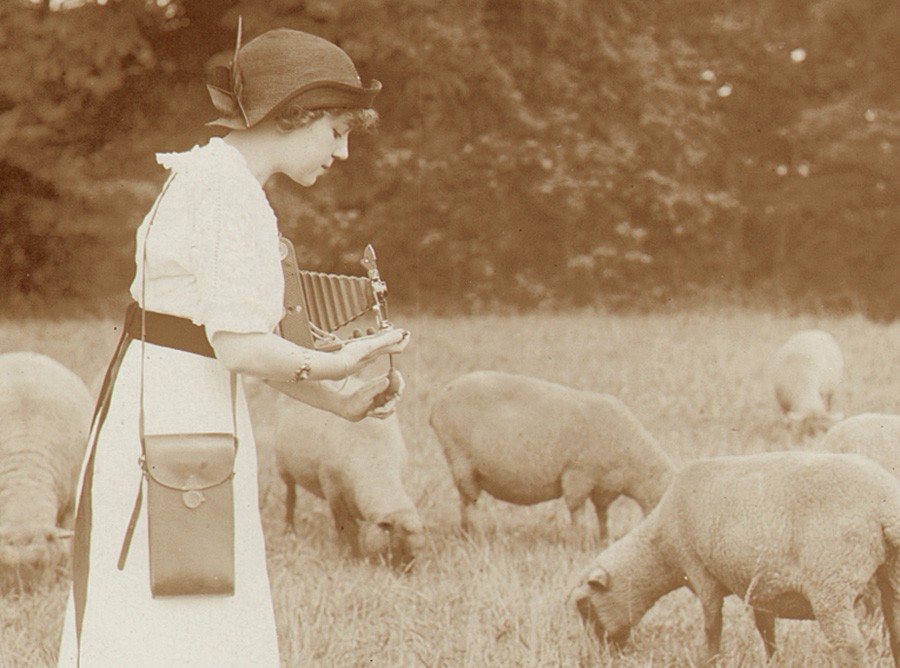 Detail: "Kodak Girl in Sheep Field" : vintage silver gelatin print: (8.7 x 11.6 cm) : ca: 1900-1920: by American (Philadelphia) photographer Edwin H. Fait: from: PhotoSeed Archive
Detail: "Kodak Girl in Sheep Field" : vintage silver gelatin print: (8.7 x 11.6 cm) : ca: 1900-1920: by American (Philadelphia) photographer Edwin H. Fait: from: PhotoSeed Archive
As noted in this site’s previous post of their colorization of an early 1908 advertising contest winner by Marian Pearce of Waukegan, IL, Kodak’s marketing genius often took the form of “candid” views of models using cameras in the field: children taking pictures with a Brownie box variety, in the case of the Pearce winning photograph, or this silver gelatin print in the PhotoSeed Archive featuring a fashionably-dressed girl releasing the bulb shutter of what appears to be a model 3A Folding Pocket Kodak. (1.)
Similar to my discovery of the Pearce image used later in an advertisement, I’ve spent more than a few hours trying to decipher if this girl with chapeau was also published, but with no luck. Among multiple sources in the search process, I’ve come across a few notable online sites including the smile-inducing KodakGirl Collection (German publishing house Steidl releases this month their marvelous addition to Kodak scholarship: Kodak Girl: from the Martha Cooper Collection ) and revisited many pages from Duke University Libraries resource Emergence of Advertising in America currently showing 550 early Kodak advertisements.
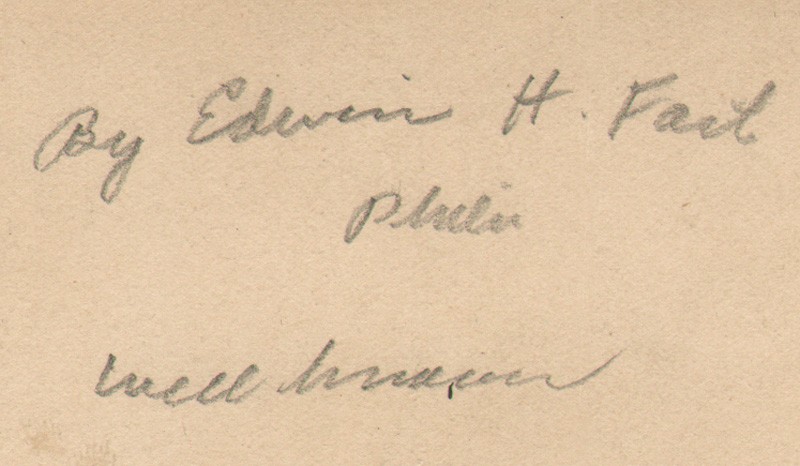 Detail: verso: "Kodak Girl in Sheep Field": graphite in unknown hand: "By Edwin H. Fait" | "Phila" | "Well known": from: PhotoSeed Archive
Detail: verso: "Kodak Girl in Sheep Field": graphite in unknown hand: "By Edwin H. Fait" | "Phila" | "Well known": from: PhotoSeed Archive
But getting back to that face. I’ve tentatively dated this photograph from 1900-1920, and the commercial nature of the image suggests deliberate posing, with the model seen in profile holding her Kodak camera to nice effect. The carrying case is also stylishly displayed-consistent with vintage advertisements from this era- slung over her shoulder and resting on her hip. I may of course be wrong, but in addition to this young lady sharing a striking resemblance to very early known photos of her, (2.) and the intriguing abbreviated reference to the city of Philadelphia on the back of the photograph, Kodak Girl in Sheep Field may very well show American silent film actress and Philadelphia native Eleanor Boardman. (1898-1991)
The photographer, as I decipher on the back of the photo, was Edwin H. Fait. (see detail above) Boardman is acknowledged to have been one of the famous Kodak Girls, appearing in color on the cover of the 1921 Kodak catalogue, but perhaps not surprisingly when it comes to celebrity, research inconsistencies are rife. She is first believed to have begun modeling in 1913-1914, when she would have been 15 or 16 years of age-consistent with the dating for this photograph. A 1931 newspaper account stated:
About the time she finished art school, Miss Boardman began posing for commercial photographers. She became famous as the Kodak Girl and was the central figure in an advertising campaign which portrayed her snapping pictures in many localities. (3.)
Whatever her mysterious identity, this Kodak girl undoubtedly inspired others from the era to pick up a camera of their own.
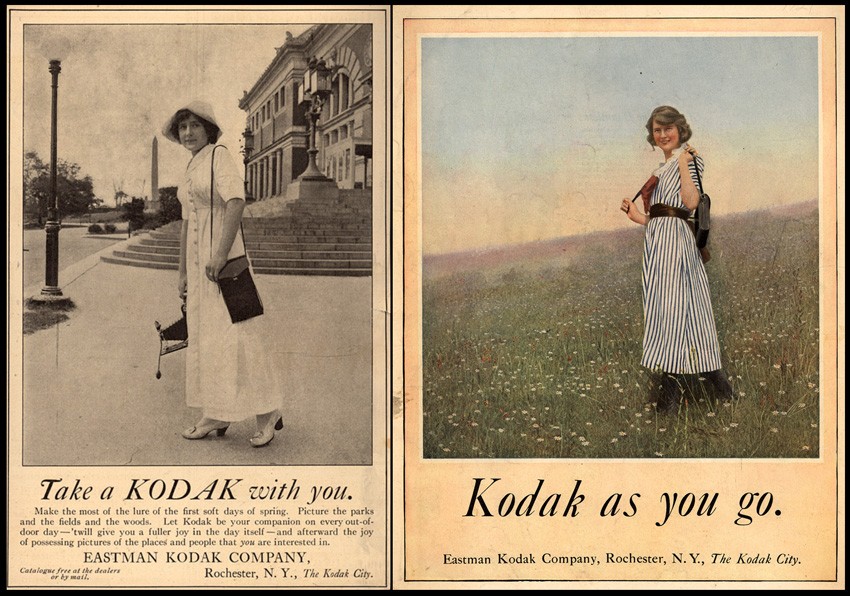 Left: "Take a Kodak with you" : vintage advertisement from unknown 1912 issue of "Ladies Home Journal": | Right: vintage advertisement: "Kodak as you go" : from: unknown source here published in 1921 but also used as cover art same year for annual Kodak catalogue: both: online resource: Emergence of Advertising in America: 1850-1920: Duke University David M. Rubenstein Rare Book & Manuscript Library
Left: "Take a Kodak with you" : vintage advertisement from unknown 1912 issue of "Ladies Home Journal": | Right: vintage advertisement: "Kodak as you go" : from: unknown source here published in 1921 but also used as cover art same year for annual Kodak catalogue: both: online resource: Emergence of Advertising in America: 1850-1920: Duke University David M. Rubenstein Rare Book & Manuscript Library
1. The 3A Folding Pocket Kodak was first introduced in 1903. Another possibility is that she holds a model 1A Special Kodak, which first came out in 1912.
2. Due to copyright considerations, I’ve elected not to show these here, although early portraits of Eleanor Boardman can be found doing common search engine image searches.
3. “Eleanor Boardman was Kodak Girl”: from: The Lewiston (ME) Daily Sun: October 15, 1931
The Beauty of Color
Posted December 2012 in Advertising, Color Photography
It is always a pleasure to run across vintage advertising featuring photographs from this archive. Marian Pearce, an amateur from Waukegan, IL, was the grand prize winner in 1908 for this original platinum photograph in the Eastman Kodak Company’s annual advertising contest. Her winning entry, featuring a young girl snapping a photo of her (presumed) younger sister with a Brownie camera appeared in the Ladies Home Journal the following year.
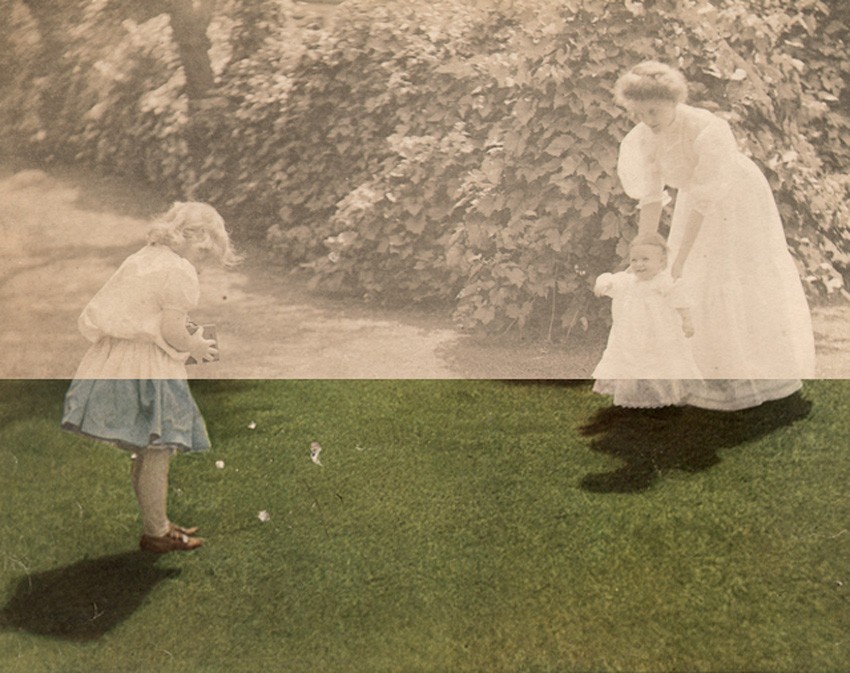 Composite illustration: top: Mrs. W.W. Pearce: black & white detail: from original platinum print: "1908 Kodak Photographic Advertising Contest First Prize Winner, Amateur Class": 15.3 x 19.3 cm | bottom: detail: 3-color halftone: from "Let the Children Kodak", by the Eastman Kodak Company reproduced in June, 1909 issue of the American magazine "Ladies Home Journal"
Composite illustration: top: Mrs. W.W. Pearce: black & white detail: from original platinum print: "1908 Kodak Photographic Advertising Contest First Prize Winner, Amateur Class": 15.3 x 19.3 cm | bottom: detail: 3-color halftone: from "Let the Children Kodak", by the Eastman Kodak Company reproduced in June, 1909 issue of the American magazine "Ladies Home Journal"
What was unexpected was seeing the photograph in the ad published in color. Eastman Kodak advertising manager L.B. Jones oversaw this campaign, with the theme of “Let the Children Kodak.” The three-color halftone process used to reproduce the photo in the June, 1909 issue of the magazine may have been the result of a hand-colored version of the Pearce photograph.
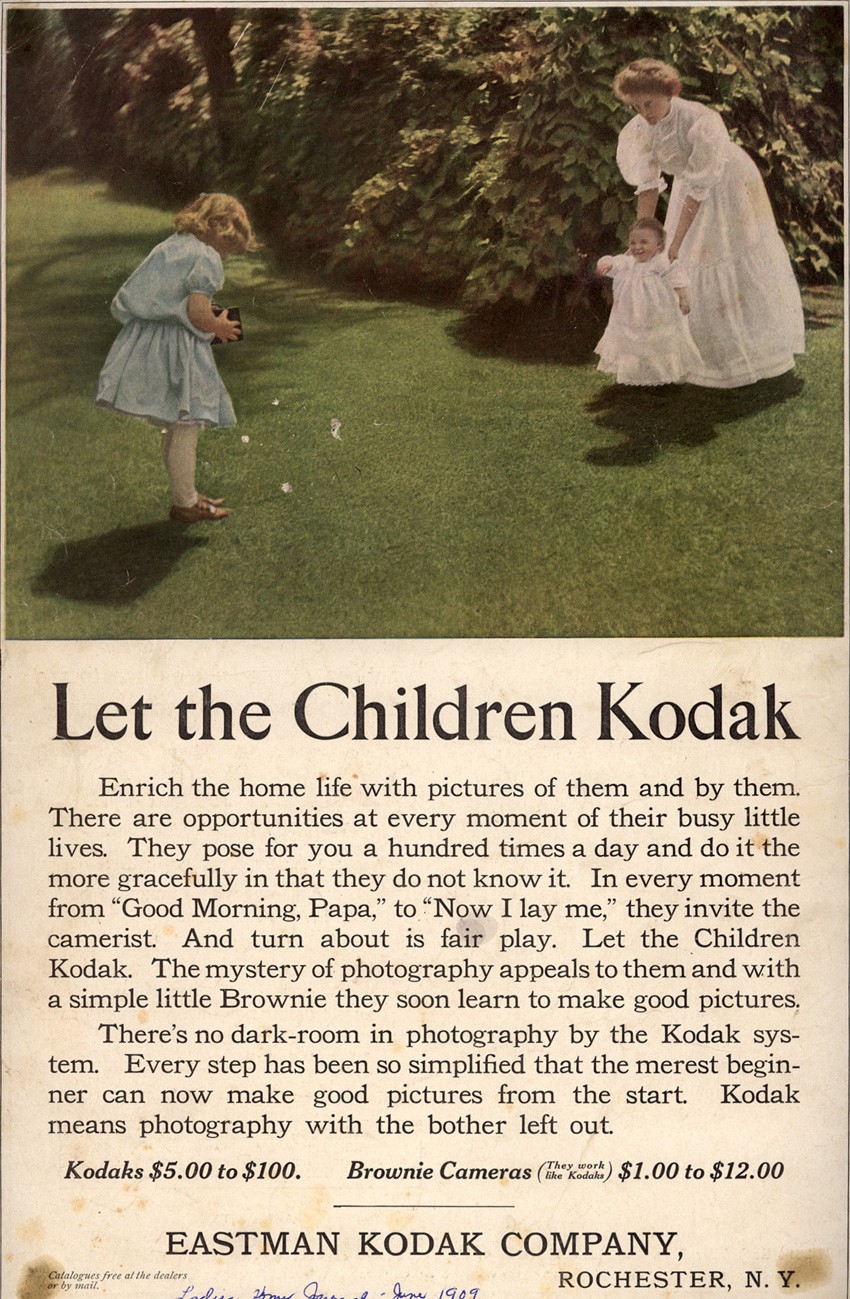 "Let the Children Kodak" : vintage advertisement in June, 1909 issue of "Ladies Home Journal": from: online resource: Emergence of Advertising in America: 1850-1920: Duke University David M. Rubenstein Rare Book & Manuscript Library
"Let the Children Kodak" : vintage advertisement in June, 1909 issue of "Ladies Home Journal": from: online resource: Emergence of Advertising in America: 1850-1920: Duke University David M. Rubenstein Rare Book & Manuscript Library
Sadly, Mrs. Pearce is not given credit for the photo in the ad, which is of course still common today, although her grand prize of $300.00 she earned in the amateur category of the 1908 contest was a king’s ransom for the time.
Now hold Still
Posted November 2012 in Advertising, Conservation
Ok, I admit it. I found the little bugger opposite the page containing the engraving of this fashionably-dressed gentleman focusing and peering into his elegant camera. When I recently opened a parcel containing several European volumes from the late 1890’s-you know-the photo kind-I was not prepared for the disaster waiting inside. Misbound, with the bindings perished and outer paper covers secured with copious amounts of glue on the inner signatures upside down, I deemed the volumes immediately breakable in order to separate and archivally preserve the very fine gravure plates within.
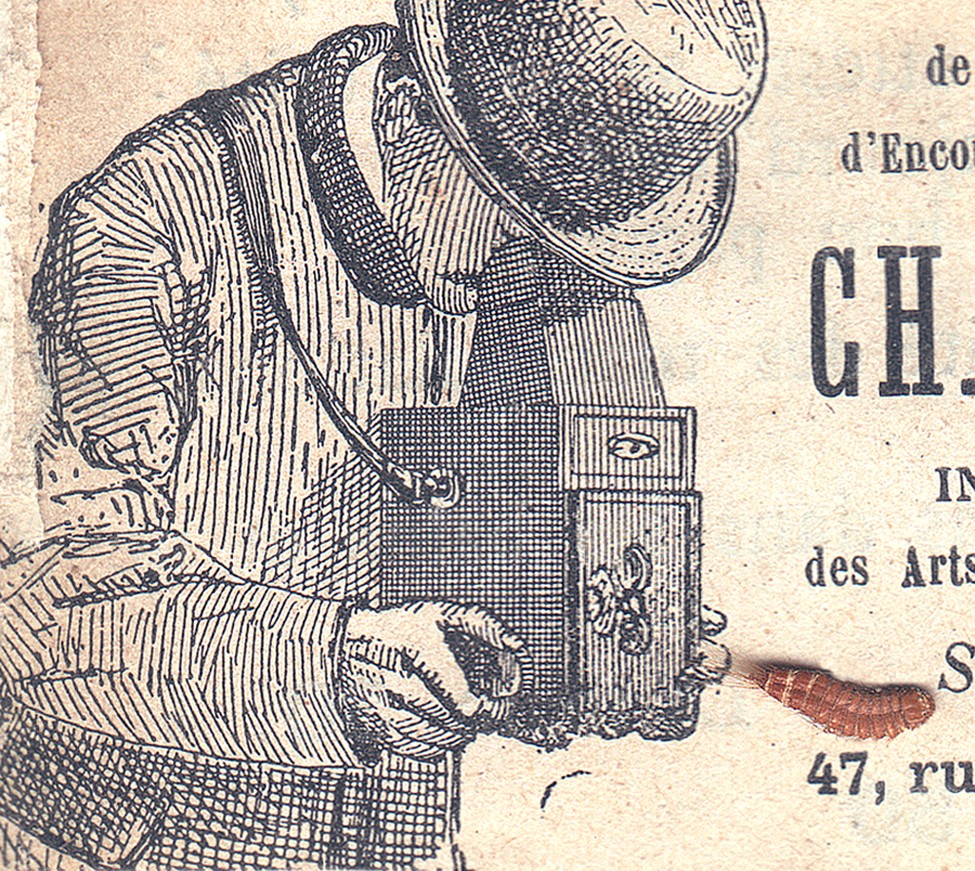 1897: Man focusing unknown make camera at a silverfish (Lepisma saccharina,): detail showing wood engraved advertisement reproduced from French photographic journal: partial advertisement copy: NOUVELLE CHAMBRE A MAIN Système Londe & Dessoudeix: Mason Ch. Dessoudeix Lauréat de la Société d’Encouragement 1894 CH. BAZIN Ingénieur des Arts et Manufactures | Successeur 47, rue du Rocher Médaile D’Or Exposition Internationale de Photographie 1892 2 Médailles D’Argent Société Française de Photographie 1892
1897: Man focusing unknown make camera at a silverfish (Lepisma saccharina,): detail showing wood engraved advertisement reproduced from French photographic journal: partial advertisement copy: NOUVELLE CHAMBRE A MAIN Système Londe & Dessoudeix: Mason Ch. Dessoudeix Lauréat de la Société d’Encouragement 1894 CH. BAZIN Ingénieur des Arts et Manufactures | Successeur 47, rue du Rocher Médaile D’Or Exposition Internationale de Photographie 1892 2 Médailles D’Argent Société Française de Photographie 1892
As a lover and caretaker of fine books, this is always the last resort. But occasionally, it is vital. Short of placing everything into a deep freeze, photographic material from any vintage, especially the old stuff, needs to be properly conserved for future generations. As for breaking a book, I’m sure many professionals would take exception to my approach, and I respect that. Certainly, all photographic conservation should be done on a case-by-case basis, and when in doubt, consult someone in the know. My own golden rules starts with wise advice I received from a George Eastman House curator many years ago: the first best defense for preservation is sometimes to do nothing at all. My own conscience however dictates intervention whenever I find photographic media in contact with the bad stuff. This usually takes the form of acidic materials in the shape of mat boards, backing boards made from real wood and other types of non-archival paper-pulp coming into direct contact with the front surface (recto) or rear support (verso) of fine photographs.
And the Silverfish about to have its picture taken? Possibly as old as the book, with its exoskeleton complimentary in color to the amber-colored adhesive used in the binding. He, she, or it probably had a good fill of the stuff before mercifully turning and playing dead for the next century or so.
March of Trade's Harmonious Shades
Posted November 2012 in Advertising, History of Photography, Journals, Publishing
The Photographic Times (1871-1915) was one of America’s earliest and most important photographic journals. By 1880, its publisher declared it the highest circulating magazine of its type in the country and by December of 1893, the first edition was stated to be 5,000 copies a week, an extraordinary number considering the inclusion by that time of a hand-pulled photogravure or collotype frontis plate. As a researcher, it would be presumptuous of me to think it possible in the modern day to present a fully-formed history of this publication without more direct corroboration from those who made that history. But since those folks are all dead, someone had to take a stab at it.
 1871-1873: The Photographic Times was first published by The Scovill Manufacturing Company, which maintained offices in this building at 36 Park Row and 4 Beekman streets in lower Manhattan. Completed in 1857 and known as the Potter or World Building, it was the home of the New York World newspaper offices and many other publications. (an adjoining building for The New York Times is at far left of frame) The sign for the Scovill Manufacturing Co. has been highlighted in red for clarity on the Park Row side. Since rebuilt, this building and block was destroyed by a massive fire on January 31, 1882 that claimed 12 lives. This detail from a circa 1870 stereoscopic view in the collection of the New York Public Library: Image ID: G91F211_034F
1871-1873: The Photographic Times was first published by The Scovill Manufacturing Company, which maintained offices in this building at 36 Park Row and 4 Beekman streets in lower Manhattan. Completed in 1857 and known as the Potter or World Building, it was the home of the New York World newspaper offices and many other publications. (an adjoining building for The New York Times is at far left of frame) The sign for the Scovill Manufacturing Co. has been highlighted in red for clarity on the Park Row side. Since rebuilt, this building and block was destroyed by a massive fire on January 31, 1882 that claimed 12 lives. This detail from a circa 1870 stereoscopic view in the collection of the New York Public Library: Image ID: G91F211_034F
Besides the written record, the important legacy left by the journal in my estimation are its hand-pulled photogravure plates which appeared regularly from 1889-1904, the latter being included in the combined but short-lived publication The Photographic Times-Bulletin. As a collector of this material for many years, it is surprising to me how little seems to have survived given the large circulation of the Times. My overview of the publication, which appears here in PhotoSeed Highlights, might very well put you to sleep due to length, or perhaps not. In tracing the history of this journal, my journey of discovery made me realize a fact of interest to all photographers, especially with respect to the United States: the first publisher of the Times, the Scovill Manufacturing Company of New York City, with a large factory complex in Waterbury, CT, was largely responsible for the birth and progress of photographic commerce in 19th century America.
 1871-1915 timeline: The Scovill company, publishers of The Photographic Times, did business at 9 different locations in New York City over 45 years. This Google street map with inset address key covers a walking distance today of approximately 4.6 miles. Arranged chronologically from A-I, the dates and addresses for the company are as follows: 1871-1873: 4 Beekman Street 1874-1884: 419-421 Broome Street 1884-1895: 423 Broome Street 1896-1900: 60-62 East 11th Street 1900 (Fall)-1902: 3-5 West 19th Street April 1902-1903: 122-124 Fifth Ave. 1904: 75-77 Eighth Ave. December, 1904-1908: 39 Union Square West 1909-1915: 135 West 14th Street
1871-1915 timeline: The Scovill company, publishers of The Photographic Times, did business at 9 different locations in New York City over 45 years. This Google street map with inset address key covers a walking distance today of approximately 4.6 miles. Arranged chronologically from A-I, the dates and addresses for the company are as follows: 1871-1873: 4 Beekman Street 1874-1884: 419-421 Broome Street 1884-1895: 423 Broome Street 1896-1900: 60-62 East 11th Street 1900 (Fall)-1902: 3-5 West 19th Street April 1902-1903: 122-124 Fifth Ave. 1904: 75-77 Eighth Ave. December, 1904-1908: 39 Union Square West 1909-1915: 135 West 14th Street
The following visual timeline is my attempt to show off the look of the publication over the 45 years it existed under its own imprint along with the principal men involved in editing it- part of the Photographic Times Publishing Association, one of the many business interests of the parent company. During this time, Scovill’s march of trade on the island of Manhattan involved eight separate business moves over a walkable distance today of roughly 4.6 miles. To this end, part of the mission statement issued by the Time’s editors to its many readers- from post American Civil War beginnings in January, 1871 to its 1915 demise remained true over the life of the journal:
we shall intersperse here and there delicate half-tones and harmonious shades from sources of information which shall do you good service in your manipulations, and add to your store of useful knowledge. We have engaged talent for this end, which is competent and able to instruct.
-David Spencer November, 2012
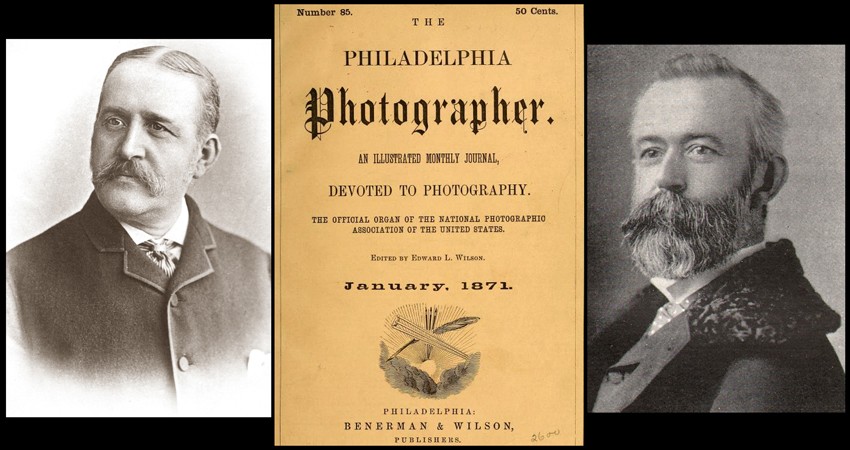 1870: The Times first appeared as a supplement incorporated within the pages of the monthly Philadelphia Photographer, center, one of the first journals devoted to photography published in America beginning in 1864. Washington Irving Adams, left, (1832-1896) came up with the idea for the Times during a working lunch attended in 1869 by men associated with the Scovill Manufacturing Company. Edward Wilson, right, (1838-1903) was the founder, editor and publisher of the Philadelphia Photographer, as well as good friend to Adams. Photo credits: portraits: PhotoSeed Archive; magazine cover: HathiTrust
1870: The Times first appeared as a supplement incorporated within the pages of the monthly Philadelphia Photographer, center, one of the first journals devoted to photography published in America beginning in 1864. Washington Irving Adams, left, (1832-1896) came up with the idea for the Times during a working lunch attended in 1869 by men associated with the Scovill Manufacturing Company. Edward Wilson, right, (1838-1903) was the founder, editor and publisher of the Philadelphia Photographer, as well as good friend to Adams. Photo credits: portraits: PhotoSeed Archive; magazine cover: HathiTrust
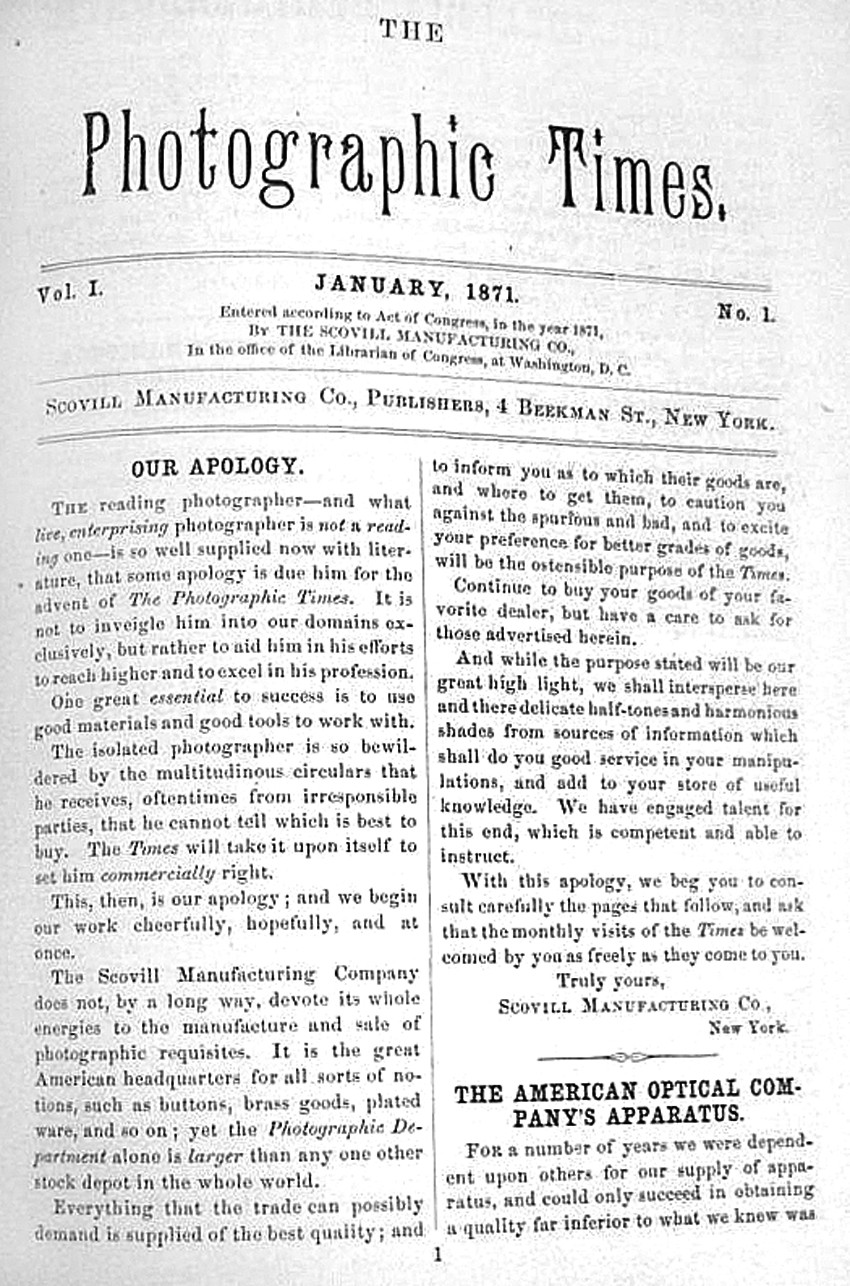 1871: The Photographic Times appeared for the first time under the imprint of the Scovill Manufacturing Company of 4 Beekman street in New York City beginning with the January, 1871 issue. The first page of the eight-page trade monthly included an "Apology", intended to "set the photographer commercially right.” It was sent out free of charge with Wilson's Philadelphia Photographer, The Photographic World, and Walzl’s Photographic Magazine, along with an additional 500 copies mailed each month from Scovill's New York offices. Photo credit: D. Richards, Bookman: Pittsburgh, PA
1871: The Photographic Times appeared for the first time under the imprint of the Scovill Manufacturing Company of 4 Beekman street in New York City beginning with the January, 1871 issue. The first page of the eight-page trade monthly included an "Apology", intended to "set the photographer commercially right.” It was sent out free of charge with Wilson's Philadelphia Photographer, The Photographic World, and Walzl’s Photographic Magazine, along with an additional 500 copies mailed each month from Scovill's New York offices. Photo credit: D. Richards, Bookman: Pittsburgh, PA
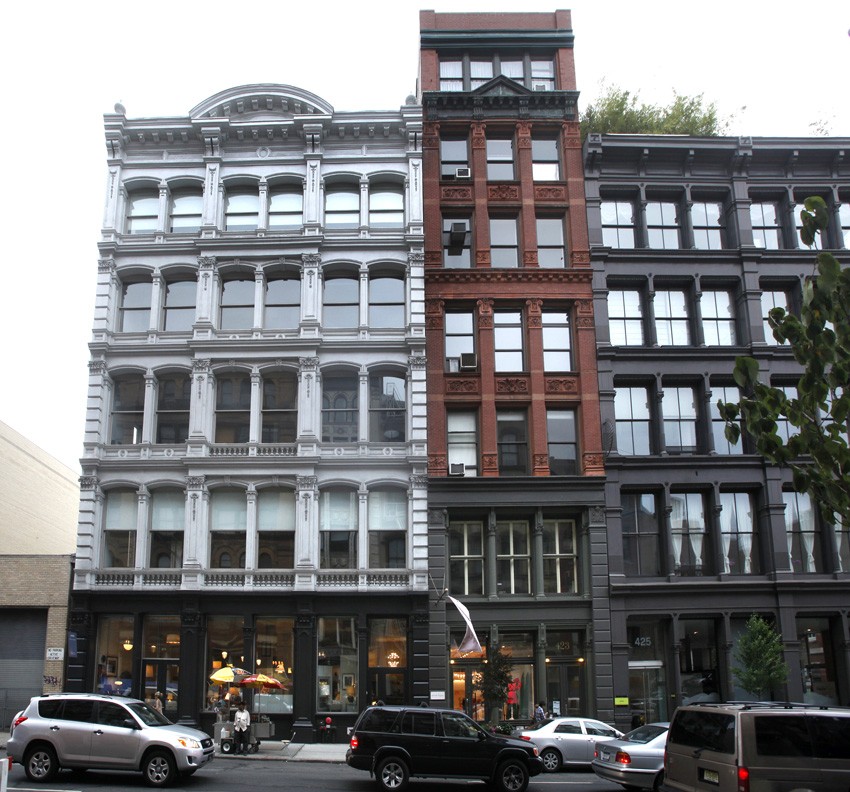 1874 | 1884: Because of "want of room and the march of trade", the Scovill company had moved to new quarters at 419-421 Broome street by January, 1874. Located in SoHo, the building as it stands today can be seen at left in a photograph taken in June, 2012. By May of 1884, another move for the Times and the Scovill company took place right next door: the building at center with the address of 423 Broome Street, built for the company by architectural firm D. & J. Jardine. Described as a warehouse building at the time, Times editor Washington Irving Adams commented on its many benefits: "This well appointed structure, embracing seven floors and a double basement, we have erected to meet the special requirements of our business. The building, with its improved interior arrangements, will greatly enlarge our facilities and enable us to respond to the wants of our patrons in a more expeditious and satisfactory manner than heretofore. For the accommodation of our friends, a well-constructed dark-room and sky-light have been added to the many other conveniences introduced, all of which will subserve in various ways the interests of our customers." PhotoSeed Archive photograph by David Spencer
1874 | 1884: Because of "want of room and the march of trade", the Scovill company had moved to new quarters at 419-421 Broome street by January, 1874. Located in SoHo, the building as it stands today can be seen at left in a photograph taken in June, 2012. By May of 1884, another move for the Times and the Scovill company took place right next door: the building at center with the address of 423 Broome Street, built for the company by architectural firm D. & J. Jardine. Described as a warehouse building at the time, Times editor Washington Irving Adams commented on its many benefits: "This well appointed structure, embracing seven floors and a double basement, we have erected to meet the special requirements of our business. The building, with its improved interior arrangements, will greatly enlarge our facilities and enable us to respond to the wants of our patrons in a more expeditious and satisfactory manner than heretofore. For the accommodation of our friends, a well-constructed dark-room and sky-light have been added to the many other conveniences introduced, all of which will subserve in various ways the interests of our customers." PhotoSeed Archive photograph by David Spencer
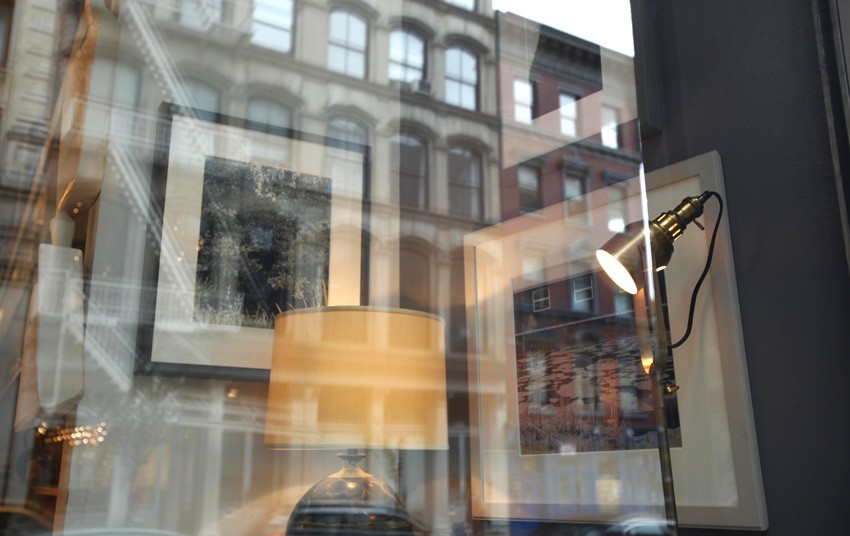 2012: Serendipity, coincidence or both? A modern day investigator peering through the front window of 419 Broome street is startled to learn the fine art of photography is alive and well nearly 140 years after this space occupied one of the leading mouthpieces of the photographic press. In the business space Aero LTD, a home furnishing store, professional photographer Michelle Arcila's work is framed and ready for sale. Her photographs "Present Tense" at left and "Olympia" share the reflected outside world of Broome street. PhotoSeed Archive photograph by David Spencer
2012: Serendipity, coincidence or both? A modern day investigator peering through the front window of 419 Broome street is startled to learn the fine art of photography is alive and well nearly 140 years after this space occupied one of the leading mouthpieces of the photographic press. In the business space Aero LTD, a home furnishing store, professional photographer Michelle Arcila's work is framed and ready for sale. Her photographs "Present Tense" at left and "Olympia" share the reflected outside world of Broome street. PhotoSeed Archive photograph by David Spencer
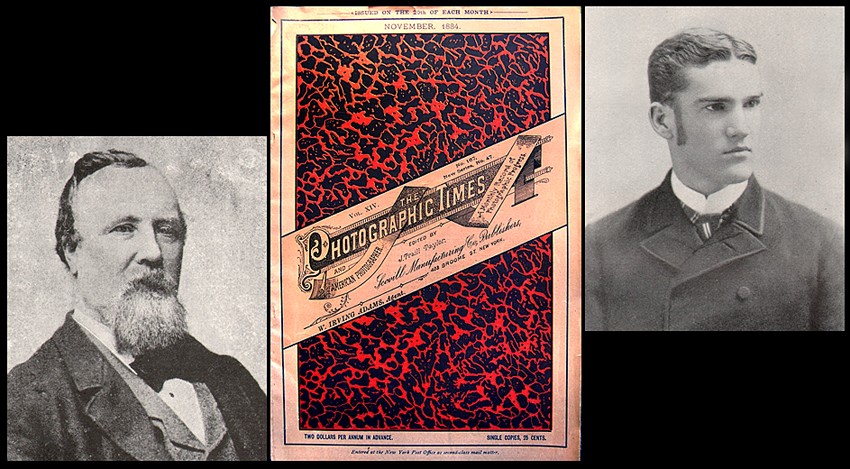 1881 | 1884 | 1885: Beginning in 1881, a new editorial direction was brought to the Times, renamed The Photographic Times and American Photographer, by Englishman John Traill Taylor, (1827-1895) left. A veteran of the British Journal of Photography, he was eventually succeeded as editor by Washington Irving Lincoln Adams, (1865-1946) right, son of the journal's founder, joining the editorial staff in 1885. At center is a rare surviving example of a Times cover from November, 1884. Photo credits: portraits: PhotoSeed Archive; magazine cover: Ebay
1881 | 1884 | 1885: Beginning in 1881, a new editorial direction was brought to the Times, renamed The Photographic Times and American Photographer, by Englishman John Traill Taylor, (1827-1895) left. A veteran of the British Journal of Photography, he was eventually succeeded as editor by Washington Irving Lincoln Adams, (1865-1946) right, son of the journal's founder, joining the editorial staff in 1885. At center is a rare surviving example of a Times cover from November, 1884. Photo credits: portraits: PhotoSeed Archive; magazine cover: Ebay
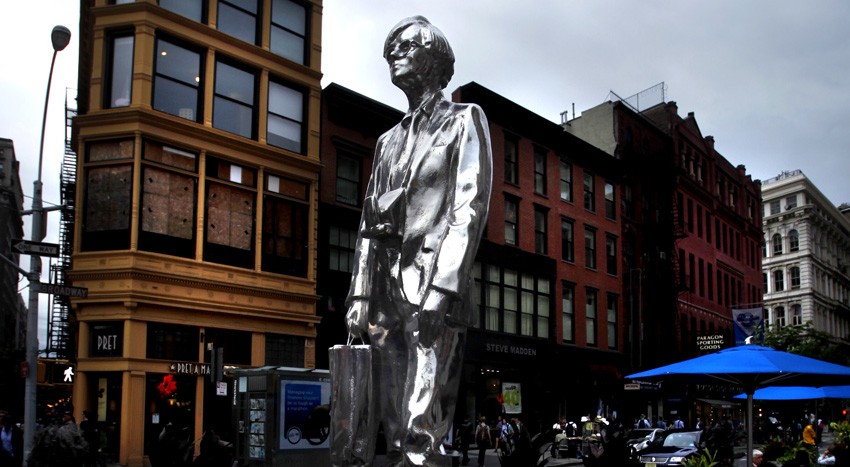 2012: Besides being the king of Pop art, Andy Warhol (1928-1987) was also a passionate photographer, going everywhere with his Polaroid camera-seen here around his neck in the famous (since removed) chrome-plated "Andy Monument" by sculptor Rob Pruitt in Union Square. A parallel or association with the Photographic Times? You bet. Albeit sixty years later, Warhol’s second "Silver Factory" was established in 1968 and located around the corner from the statue at 33 Union Square West, just three doors down from 39 Union Square, one of the last home offices for the Times from 1904-1908. PhotoSeed Archive photograph (June) by David Spencer
2012: Besides being the king of Pop art, Andy Warhol (1928-1987) was also a passionate photographer, going everywhere with his Polaroid camera-seen here around his neck in the famous (since removed) chrome-plated "Andy Monument" by sculptor Rob Pruitt in Union Square. A parallel or association with the Photographic Times? You bet. Albeit sixty years later, Warhol’s second "Silver Factory" was established in 1968 and located around the corner from the statue at 33 Union Square West, just three doors down from 39 Union Square, one of the last home offices for the Times from 1904-1908. PhotoSeed Archive photograph (June) by David Spencer
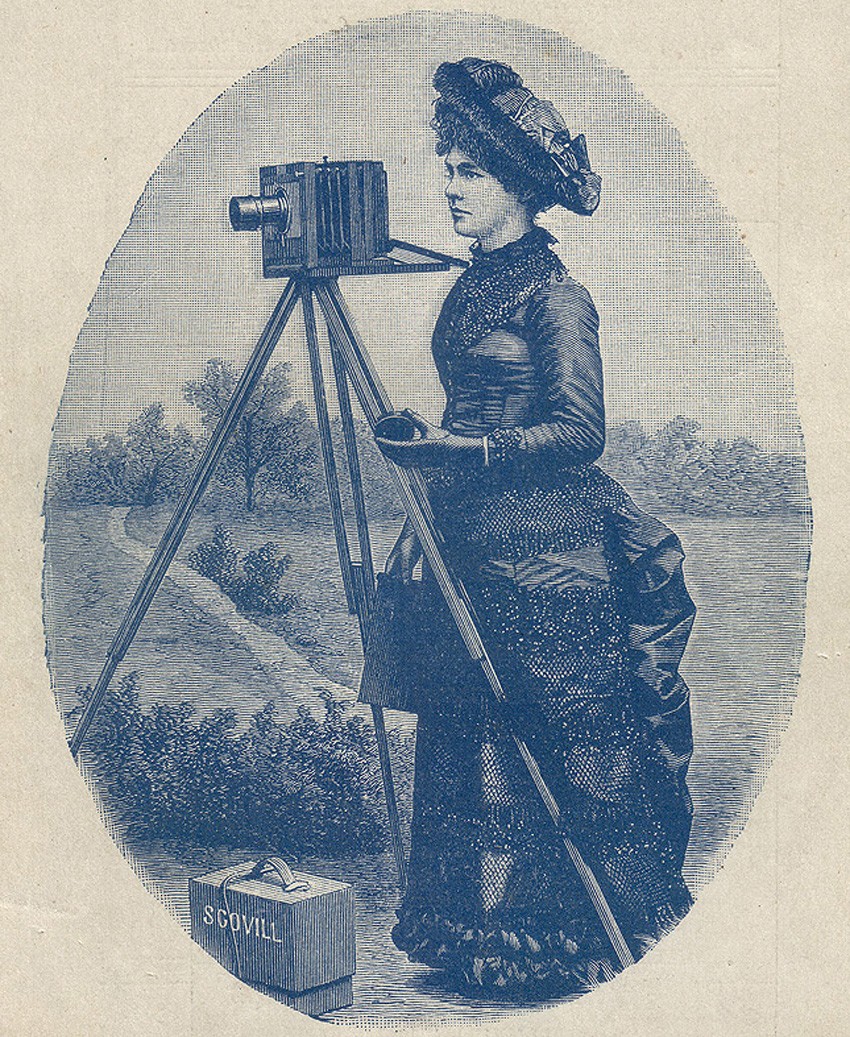 1883: With modern dry gelatin photographic plates replacing the cumbersome wet plate (collodion) process around 1881, the Scovill company through their publications including the Photographic Times began marketing in earnest complete and affordable amateur outfits to the masses. This fashionably dressed lady amateur, appearing as early as 1883 as a wood engraving in Scovill's catalogue: "How to Make Photographs", advertised their "Amateur Photographic Requisites". For the grand sum of $10.00, a photographer could obtain "Favorite Outfit A": an adjustable 4 x 5 Scovill plate camera, "Waterbury" achromatic nickel plated lens, a Taylor folding tripod, a double dry plate holder for the camera and carrying case. After becoming the Scovill & Adams company in 1889, the firm developed other popular mass market cameras including the Henry Clay and Solograph models as well as many others. 1889 engraving from Scovill catalogue courtesy of Larry Pierce.
1883: With modern dry gelatin photographic plates replacing the cumbersome wet plate (collodion) process around 1881, the Scovill company through their publications including the Photographic Times began marketing in earnest complete and affordable amateur outfits to the masses. This fashionably dressed lady amateur, appearing as early as 1883 as a wood engraving in Scovill's catalogue: "How to Make Photographs", advertised their "Amateur Photographic Requisites". For the grand sum of $10.00, a photographer could obtain "Favorite Outfit A": an adjustable 4 x 5 Scovill plate camera, "Waterbury" achromatic nickel plated lens, a Taylor folding tripod, a double dry plate holder for the camera and carrying case. After becoming the Scovill & Adams company in 1889, the firm developed other popular mass market cameras including the Henry Clay and Solograph models as well as many others. 1889 engraving from Scovill catalogue courtesy of Larry Pierce.
 1886: Dr. Charles Ehrmann, (1822-1894) a pharmaceutical chemist by training at the University of Berlin, joined the Photographic Times as an assistant editor under John Traill Taylor beginning in 1881. His obituary penned by Frederick Beach in the American Amateur Photographer said he became the "guiding editorial spirit" for the Times after Taylor's retirement in 1886, even under Lincoln Adams, and was the journal's "chief experimentalist- investigating and writing in the pages of the Times the myriad processes then used in traditional wet darkroom photography. In the Fall of 1886, Ehrmann was named instructor in the newly established Chautauqua University School of Photography, chiefly a correspondence school, but also one where he gave hands-on instruction in photography with diplomas awarded from the summer home in upstate New York as well as the Broome street offices of the Times. This photograph of Ehrmann appeared as a full-page plate in the May 25, 1888 issue of the Times. Photo credit: HathiTrust
1886: Dr. Charles Ehrmann, (1822-1894) a pharmaceutical chemist by training at the University of Berlin, joined the Photographic Times as an assistant editor under John Traill Taylor beginning in 1881. His obituary penned by Frederick Beach in the American Amateur Photographer said he became the "guiding editorial spirit" for the Times after Taylor's retirement in 1886, even under Lincoln Adams, and was the journal's "chief experimentalist- investigating and writing in the pages of the Times the myriad processes then used in traditional wet darkroom photography. In the Fall of 1886, Ehrmann was named instructor in the newly established Chautauqua University School of Photography, chiefly a correspondence school, but also one where he gave hands-on instruction in photography with diplomas awarded from the summer home in upstate New York as well as the Broome street offices of the Times. This photograph of Ehrmann appeared as a full-page plate in the May 25, 1888 issue of the Times. Photo credit: HathiTrust
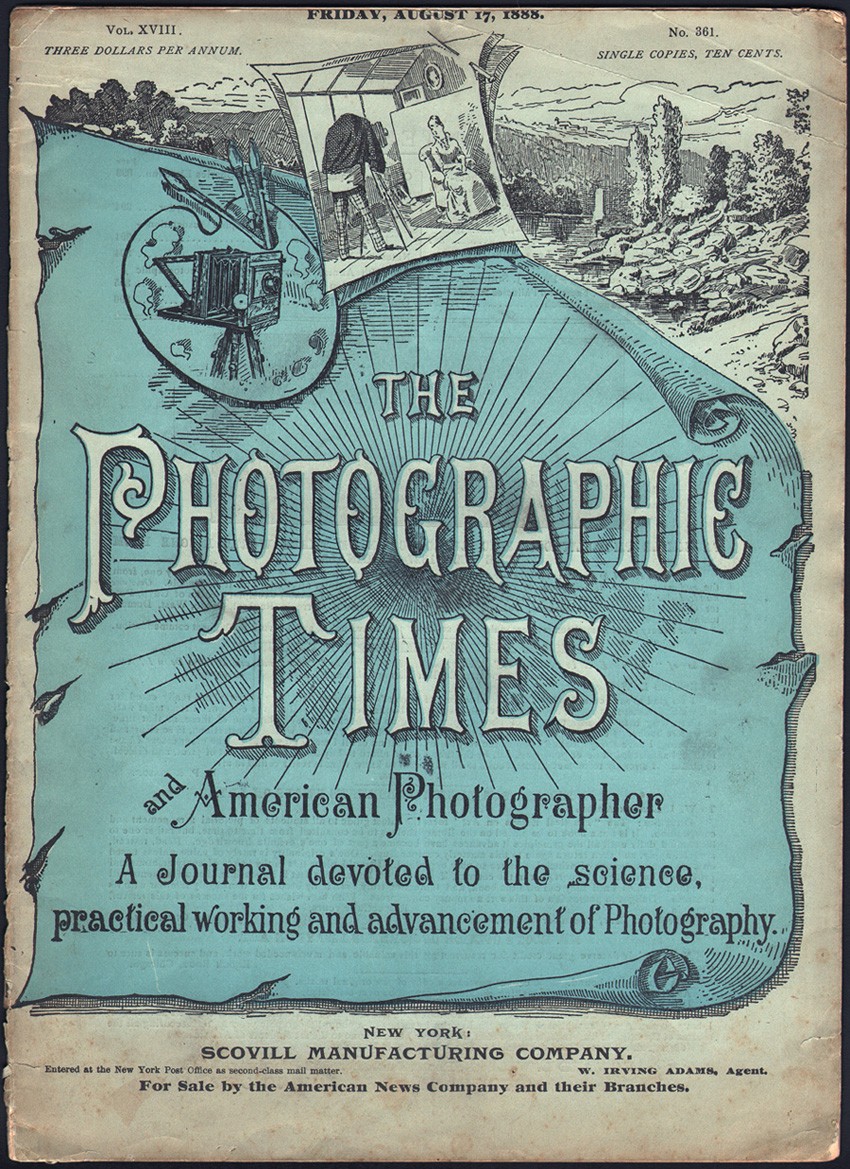 1887-1888: This is an example of a cover from The Photographic Times and American Photographer dated Friday, August 17, 1888. This was the same design used for the journal in 1887. (unknown if it was used before 1887) The quarto format journal was printed in blue and black with the artwork possibly being by the hand of Brooklyn artist William Mozart. From: PhotoSeed Archive
1887-1888: This is an example of a cover from The Photographic Times and American Photographer dated Friday, August 17, 1888. This was the same design used for the journal in 1887. (unknown if it was used before 1887) The quarto format journal was printed in blue and black with the artwork possibly being by the hand of Brooklyn artist William Mozart. From: PhotoSeed Archive
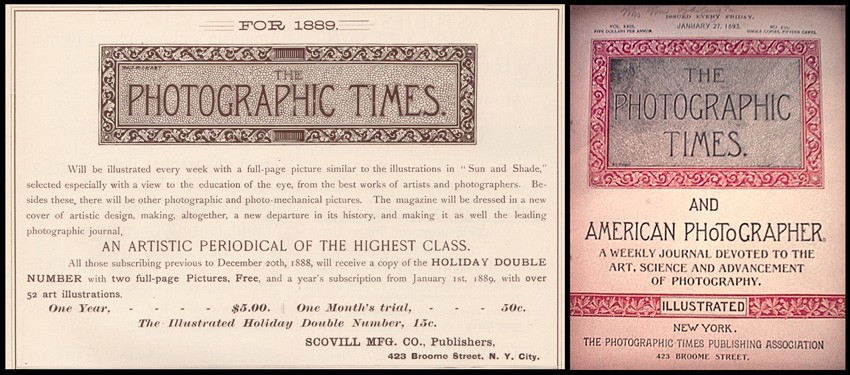 1889: This year brought a complete redesign to the look of the Times. Brooklyn artist and photographer William J. Mozart, (b. 1855) who had honed his skill first as a scene painter at a Boston museum beginning in 1878 came up with the logo seen here at left, incorporated within a January, 1889 advertisement for the Times in the periodical Sun and Shade. "The magazine will be dressed in a new cover of artistic design, making, altogether, a new departure in its history, and making it as well the leading photographic journal." The weekly would also for the first time feature in every issue a full-page illustration, typically a photogravure or fine process collotype. At right is an example of the new cover by Mozart. (this issue from January, 1893). Advertisement from PhotoSeed Archive; cover: Crown Antiques & Collectible
1889: This year brought a complete redesign to the look of the Times. Brooklyn artist and photographer William J. Mozart, (b. 1855) who had honed his skill first as a scene painter at a Boston museum beginning in 1878 came up with the logo seen here at left, incorporated within a January, 1889 advertisement for the Times in the periodical Sun and Shade. "The magazine will be dressed in a new cover of artistic design, making, altogether, a new departure in its history, and making it as well the leading photographic journal." The weekly would also for the first time feature in every issue a full-page illustration, typically a photogravure or fine process collotype. At right is an example of the new cover by Mozart. (this issue from January, 1893). Advertisement from PhotoSeed Archive; cover: Crown Antiques & Collectible
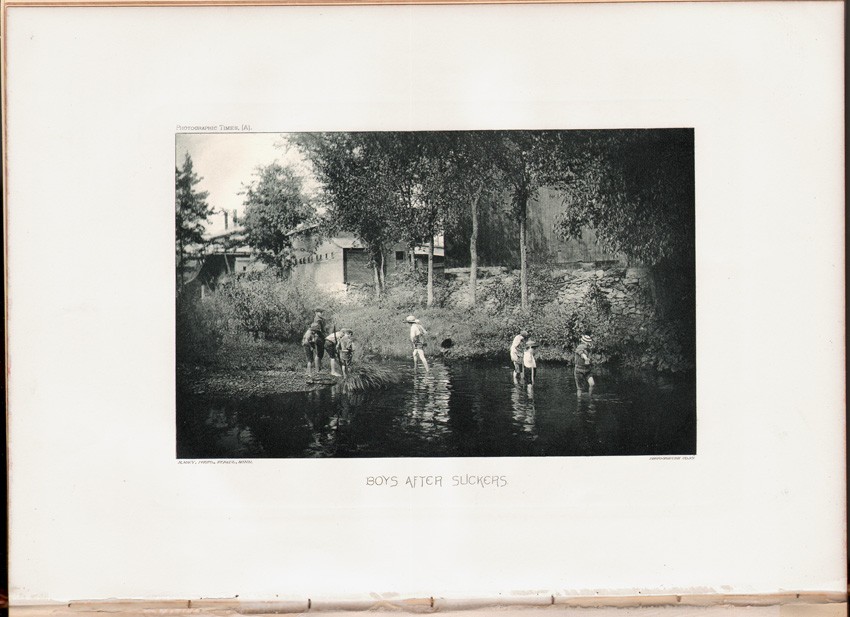 1889: "Boys after Suckers" by Minnesota photographer Rev. Herbert Macy, was the photogravure frontis plate for the April 18, 1890 weekly issue of the Times. Image: 11.2 x 17.9 cm | Support: 20.5 x 28.7 cm Photogravures such as these were a major selling point for potential subscribers, with the cost of a yearly subscription being $5.00. In 1893, the editors wrote: "The PHOTOGRAPHIC TIMES had frequently brought out full-page pictorial illustrations, in addition to the cuts and diagrams which always brightened its reading columns; but beginning with 1889, it presented its readers regularly, each week, with a full-page pictorial frontispiece, reproduced by photogravure or other high grade process, and including an occasional photographic print on albumen or other sensitive paper. It thus became the first and continues to be the only photographic weekly publication in the world, containing a full-page picture with every issue." Photo: PhotoSeed Archive
1889: "Boys after Suckers" by Minnesota photographer Rev. Herbert Macy, was the photogravure frontis plate for the April 18, 1890 weekly issue of the Times. Image: 11.2 x 17.9 cm | Support: 20.5 x 28.7 cm Photogravures such as these were a major selling point for potential subscribers, with the cost of a yearly subscription being $5.00. In 1893, the editors wrote: "The PHOTOGRAPHIC TIMES had frequently brought out full-page pictorial illustrations, in addition to the cuts and diagrams which always brightened its reading columns; but beginning with 1889, it presented its readers regularly, each week, with a full-page pictorial frontispiece, reproduced by photogravure or other high grade process, and including an occasional photographic print on albumen or other sensitive paper. It thus became the first and continues to be the only photographic weekly publication in the world, containing a full-page picture with every issue." Photo: PhotoSeed Archive
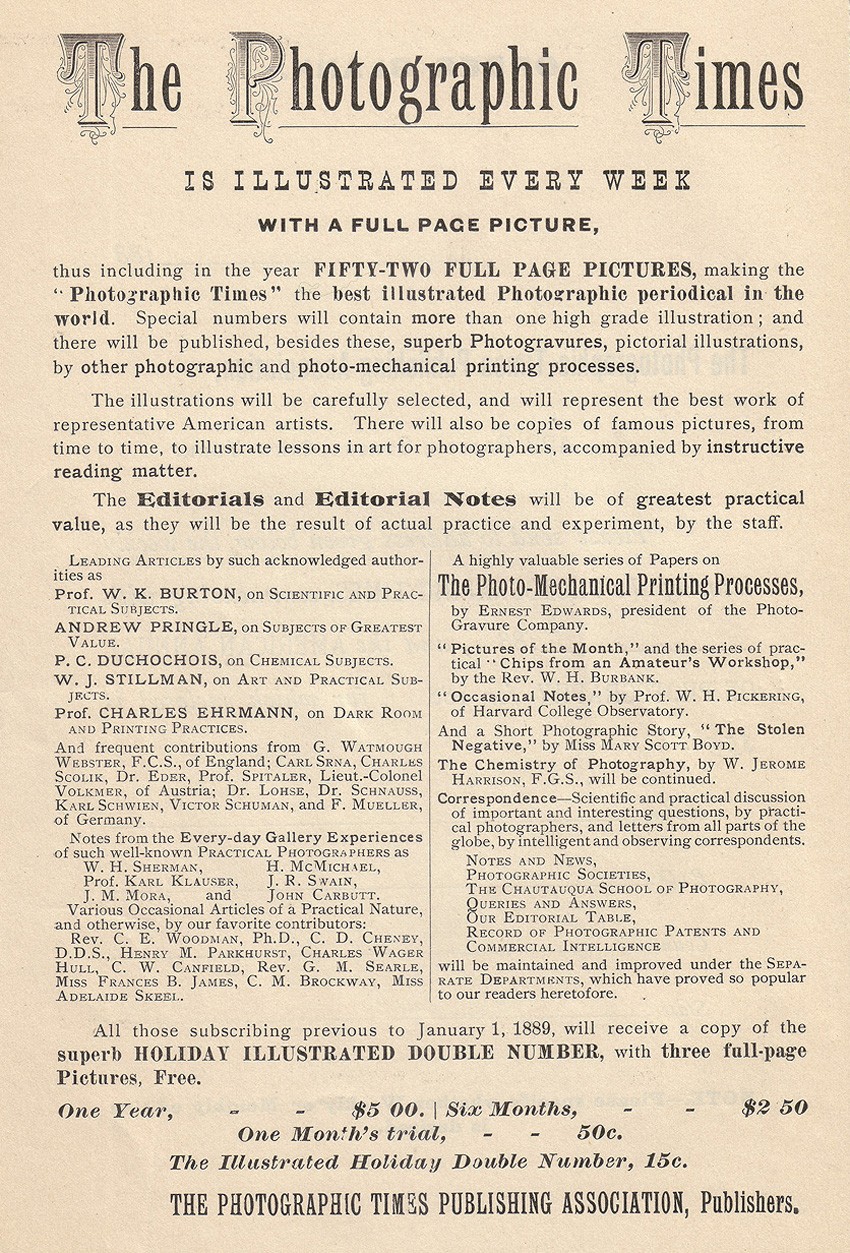 1889: With its new emphasis on high-grade illustrations that would be reproduced each week, other particulars and selling points, including the following quote, appeared in the 1889 Scovill & Adams company trade brochure "How to Make Photographs" : "The Editorials and Editorial Notes will be of greatest practical value, as they will be the result of actual practice and experiment, by the staff." Advertisement courtesy of Larry Pierce.
1889: With its new emphasis on high-grade illustrations that would be reproduced each week, other particulars and selling points, including the following quote, appeared in the 1889 Scovill & Adams company trade brochure "How to Make Photographs" : "The Editorials and Editorial Notes will be of greatest practical value, as they will be the result of actual practice and experiment, by the staff." Advertisement courtesy of Larry Pierce.
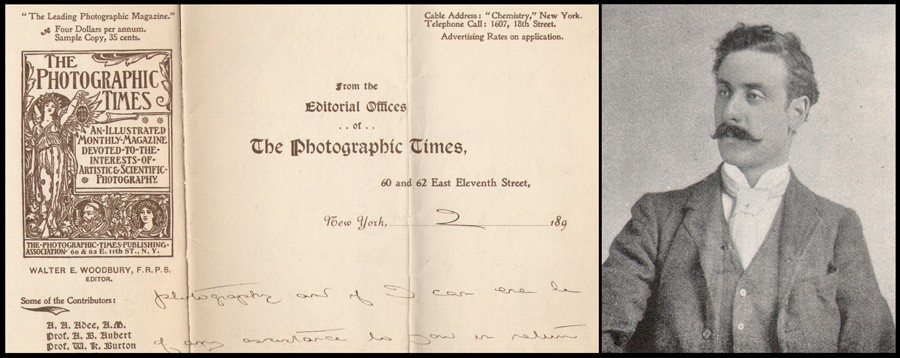 1893: In the Spring of this year, Walter Edward Woodbury, (1865-1905) seen at right around this time, joined the editorial staff of the Times, and before the end of 1894 was appointed editor by Lincoln Adams. A Fellow of the Royal Photographic Society and son of Englishman Walter Bentley Woodbury, (1834-1885) he oversaw major changes to the Times, including its transformation to a monthly and into a “high-class art magazine”. Perhaps the most noticeable change of this last aspect for a subscriber was the dramatic new cover design featuring Roman goddess Veritas holding out her lamp symbolically lighting the way for truth, designed by English bookplate artist George Richard Quested. The design was even incorporated into Woodbury's personalized Times letterhead, a detail of which can be seen here. Letterhead and portrait: PhotoSeed Archive
1893: In the Spring of this year, Walter Edward Woodbury, (1865-1905) seen at right around this time, joined the editorial staff of the Times, and before the end of 1894 was appointed editor by Lincoln Adams. A Fellow of the Royal Photographic Society and son of Englishman Walter Bentley Woodbury, (1834-1885) he oversaw major changes to the Times, including its transformation to a monthly and into a “high-class art magazine”. Perhaps the most noticeable change of this last aspect for a subscriber was the dramatic new cover design featuring Roman goddess Veritas holding out her lamp symbolically lighting the way for truth, designed by English bookplate artist George Richard Quested. The design was even incorporated into Woodbury's personalized Times letterhead, a detail of which can be seen here. Letterhead and portrait: PhotoSeed Archive
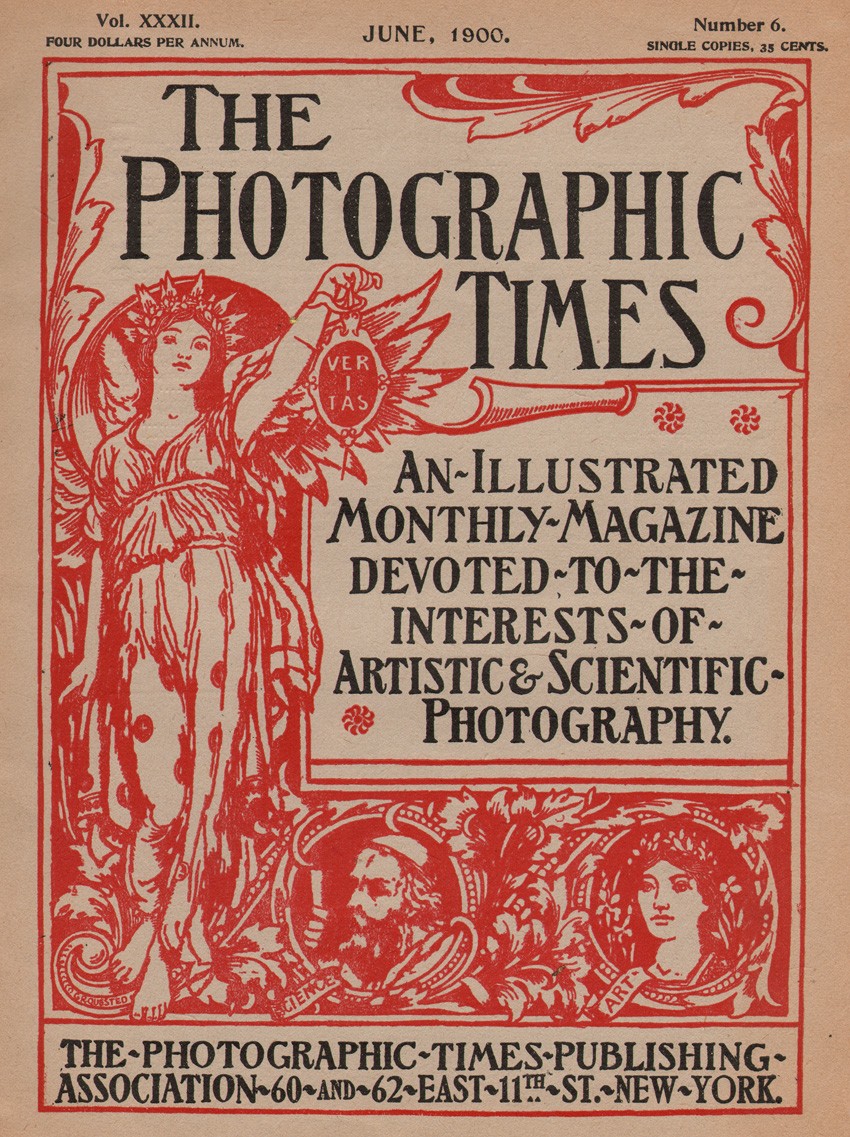 1895: The Veritas cover by Quested first used beginning in 1895 lasted through 1901, albeit in a smaller format that year. Printed in bold red ink, his design additionally featured inset portrait medallions of Science, represented by a bearded gentleman, and Art, by a fair maiden crowned by laurels. The previous weekly cover had stated: "A weekly journal devoted to the art, science and advancement of Photography" and the new monthly stated: "An illustrated monthly magazine devoted to the interests of Artistic & Scientific Photography." Sizes for cover- 1895-1900: (detail here eliminating part of borders) 29.3 x 22.5 cm; 1901: 25.0 x 17.5 cm. Cover, June, 1900: PhotoSeed Archive
1895: The Veritas cover by Quested first used beginning in 1895 lasted through 1901, albeit in a smaller format that year. Printed in bold red ink, his design additionally featured inset portrait medallions of Science, represented by a bearded gentleman, and Art, by a fair maiden crowned by laurels. The previous weekly cover had stated: "A weekly journal devoted to the art, science and advancement of Photography" and the new monthly stated: "An illustrated monthly magazine devoted to the interests of Artistic & Scientific Photography." Sizes for cover- 1895-1900: (detail here eliminating part of borders) 29.3 x 22.5 cm; 1901: 25.0 x 17.5 cm. Cover, June, 1900: PhotoSeed Archive
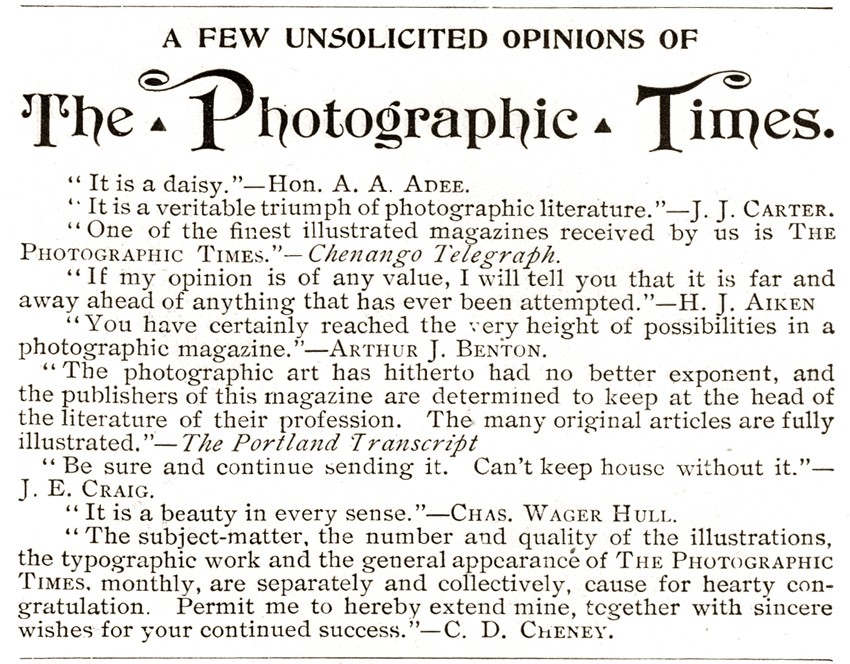 1896: Over-the-top reviews appeared frequently in various publications published by the Scovill & Adams firm in praise of the Times. One very widely-circulated volume for these praises was their annual published since 1887 titled “The American Annual of Photography and Photographic Times Almanac”, a compendium that had attained a circulation of over 20,000 copies by 1894. This advertisement of "unsolicited opinions" appeared in the advertising section of the 1896 annual. From: PhotoSeed Archive
1896: Over-the-top reviews appeared frequently in various publications published by the Scovill & Adams firm in praise of the Times. One very widely-circulated volume for these praises was their annual published since 1887 titled “The American Annual of Photography and Photographic Times Almanac”, a compendium that had attained a circulation of over 20,000 copies by 1894. This advertisement of "unsolicited opinions" appeared in the advertising section of the 1896 annual. From: PhotoSeed Archive
 1896 | 2012: As stated early in this post, the Scovill company, known since 1889 as Scovill & Adams, moved many times on the island of Manhattan. In 1896, they vacated their headquarters at 423 Broome street and took occupancy of a brand new, seven-story building specifically built for the company off of Broadway at 60 and 62 East Eleventh Street. Seen in this artist's drawing at left published in the January, 1896 issue of the Times, the editors said: "Our New Offices will be in the same building. The editorial rooms and offices will be situated on the main floor of the building. A very complete photographic and reference library will be conveniently arranged in the editorial rooms, and on the roof will be erected a finely fitted up dark-room and skylight gallery. These will be at the disposal of all our subscribers and friends." Scovill would stay in the building until the Fall of 1900. The building, housing the company Bijan Royal Inc. on the ground floor, can be seen today at right photographed in June, 2012. PhotoSeed Archive, left; right: photograph by David Spencer
1896 | 2012: As stated early in this post, the Scovill company, known since 1889 as Scovill & Adams, moved many times on the island of Manhattan. In 1896, they vacated their headquarters at 423 Broome street and took occupancy of a brand new, seven-story building specifically built for the company off of Broadway at 60 and 62 East Eleventh Street. Seen in this artist's drawing at left published in the January, 1896 issue of the Times, the editors said: "Our New Offices will be in the same building. The editorial rooms and offices will be situated on the main floor of the building. A very complete photographic and reference library will be conveniently arranged in the editorial rooms, and on the roof will be erected a finely fitted up dark-room and skylight gallery. These will be at the disposal of all our subscribers and friends." Scovill would stay in the building until the Fall of 1900. The building, housing the company Bijan Royal Inc. on the ground floor, can be seen today at right photographed in June, 2012. PhotoSeed Archive, left; right: photograph by David Spencer
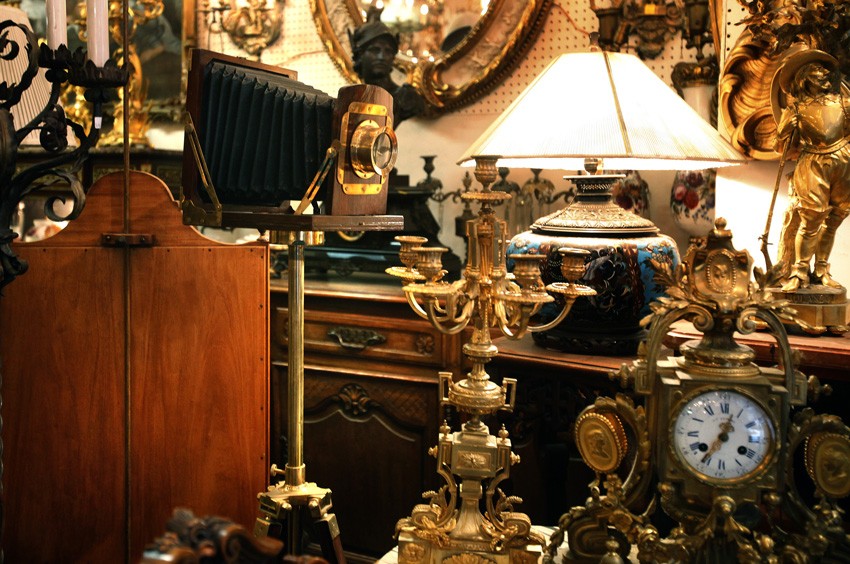 2012: More serendipity in the modern day or crazy fluke? A visit to the current first floor showroom space of antique dealer Bijan Royal at 60 East 11th street in June miraculously revealed on display this impressive looking, tripod-mounted plate camera. Quizzing a salesman produced no more details of its history however. Instead, he was keen on photo-copying the 1896 artist drawing of the building I showed him earlier while explaining my mission. Scovill & Adams in their day here made millions of dollars selling cameras like this one (even though it suspiciously appeared more ornamental than functional) as well as every conceivable photographic accessory known to man. For this space in its day formerly held one of the greatest photographic stock houses on the planet-with the Photographic Times offices in this space producing monthly the physical embodiment of the day's most important social media. PhotoSeed Archive photo by David Spencer
2012: More serendipity in the modern day or crazy fluke? A visit to the current first floor showroom space of antique dealer Bijan Royal at 60 East 11th street in June miraculously revealed on display this impressive looking, tripod-mounted plate camera. Quizzing a salesman produced no more details of its history however. Instead, he was keen on photo-copying the 1896 artist drawing of the building I showed him earlier while explaining my mission. Scovill & Adams in their day here made millions of dollars selling cameras like this one (even though it suspiciously appeared more ornamental than functional) as well as every conceivable photographic accessory known to man. For this space in its day formerly held one of the greatest photographic stock houses on the planet-with the Photographic Times offices in this space producing monthly the physical embodiment of the day's most important social media. PhotoSeed Archive photo by David Spencer
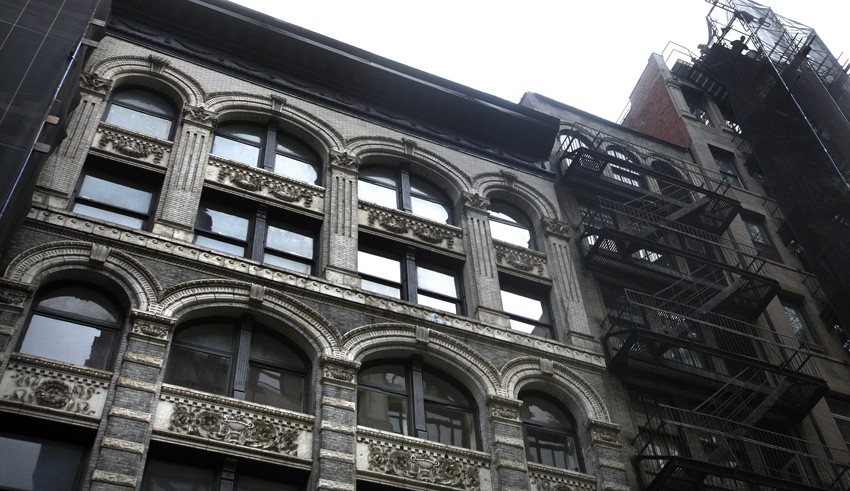 2012: A view of the facade showing the top floors of 60-62 East 11th. "The lofts will be reserved for the storage of original cases and other unpacked goods. A specially constructed dark-room for the use of their patrons and friends will be conveniently situated, and on the roof of the building there will be a commodious skylight, with light facing north, for experimental and testing purposes." During my visit, I tried my best to talk my way up to the top floor of the building to see if the skylight still existed, but to no avail. A quick search on the web indicates creative folks inhabit the seventh floor: music agency Crush Talent Management- so hooray for that. PhotoSeed Archive photo by David Spencer
2012: A view of the facade showing the top floors of 60-62 East 11th. "The lofts will be reserved for the storage of original cases and other unpacked goods. A specially constructed dark-room for the use of their patrons and friends will be conveniently situated, and on the roof of the building there will be a commodious skylight, with light facing north, for experimental and testing purposes." During my visit, I tried my best to talk my way up to the top floor of the building to see if the skylight still existed, but to no avail. A quick search on the web indicates creative folks inhabit the seventh floor: music agency Crush Talent Management- so hooray for that. PhotoSeed Archive photo by David Spencer
 1897: This extremely rare lithographic Photographic Times poster held and conserved by the Library of Congress in Washington D.C. was described in the April issue of the journal as follows: "We have had prepared for us a very attractive poster in seven colors. We give a half-tone reproduction of it herewith. Photographic dealers and newsagents will find this a valuable aid in obtaining subscriptions for this magazine. We will send one free on application and a promise that the same will be prominently displayed. The size of the poster is about 2x3 feet." Poster: Library of Congress
1897: This extremely rare lithographic Photographic Times poster held and conserved by the Library of Congress in Washington D.C. was described in the April issue of the journal as follows: "We have had prepared for us a very attractive poster in seven colors. We give a half-tone reproduction of it herewith. Photographic dealers and newsagents will find this a valuable aid in obtaining subscriptions for this magazine. We will send one free on application and a promise that the same will be prominently displayed. The size of the poster is about 2x3 feet." Poster: Library of Congress
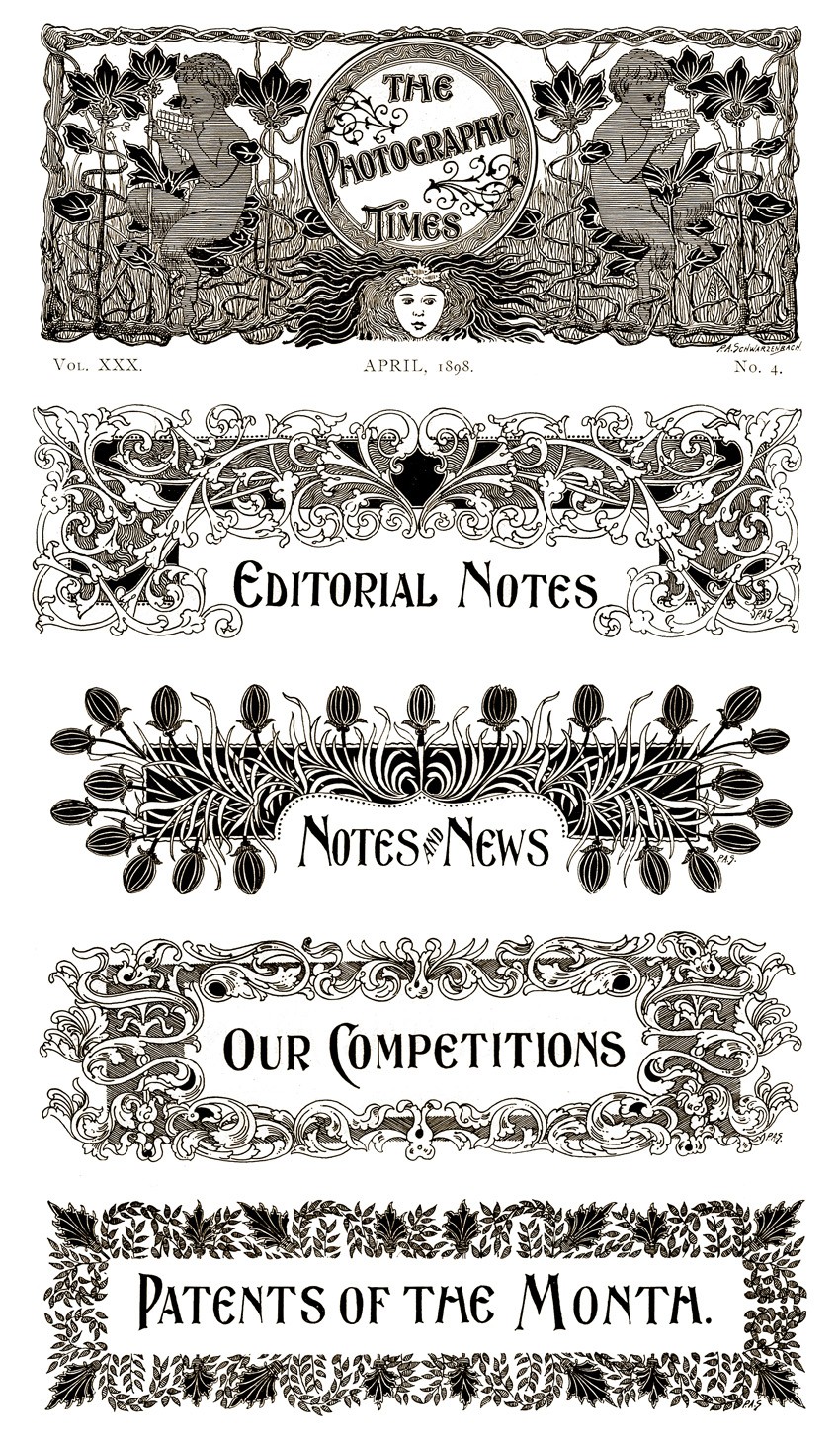 1898: In keeping with the spirit of the re-designed monthly after 1895- a "64-page artistic and scientific magazine of the very highest order" in the words of Times advertising copy from the period- illustrator P.A. Schwarzenbach supplied these decorative, Art-Nouveau inspired woodcut designs used to delineate the various departments within the editorial copy section of the journal. These specific floral designs were used during 1898 (and some before) and later into the new century. Additional Schwarzenbach designs appearing later included "Our Monthly Digest" and "The Editor's Table". Various designs, enhanced for clarity, with each approximately 6.5 x 15.5 cm ( +/-) from: PhotoSeed Archive
1898: In keeping with the spirit of the re-designed monthly after 1895- a "64-page artistic and scientific magazine of the very highest order" in the words of Times advertising copy from the period- illustrator P.A. Schwarzenbach supplied these decorative, Art-Nouveau inspired woodcut designs used to delineate the various departments within the editorial copy section of the journal. These specific floral designs were used during 1898 (and some before) and later into the new century. Additional Schwarzenbach designs appearing later included "Our Monthly Digest" and "The Editor's Table". Various designs, enhanced for clarity, with each approximately 6.5 x 15.5 cm ( +/-) from: PhotoSeed Archive
 1900: A few thoughts on Times editorial and advertising matter having to do with race. Going through old issues from the late 19th and early 20th century, I've run into that proverbial "elephant in the room" on more than one occasion: unflattering depictions of African-Americans, typically children. Through word and image, there is plenty of reason to believe this usage was not limited to mass-market American photographic journals but extended to many imprints of the era. One case in point seen here. Through modern eyes, a Times page designer going for the cheap laugh in representing monetary decision making and its potential outcomes for the amateur photographer for an article on the conundrum of photography being an affordable hobby used a series of vignettes of children stripped along the top and bottom of a page. These expressive "studies in black… and white" conveniently featured skin colors of the opposite hue for the January, 1896 article "It Costs Too Much". A mild example perhaps but one that made me wince when I first came across it. On the other hand, photographic depictions of African-Americans showing merit and historical importance do show up in the pages of the Times-even when done in the period genre style favored by American Rudolph Eickemeyer, Jr. At right, a fine example: a full-page halftone study of an elderly former slave titled "Thoughts of Other Days" from the October, 1900 issue- itself an advertisement for his book "Down South" published that year. Dimensions for "Thoughts": 22.5 x 17.7 cm. Both images: PhotoSeed Archive
1900: A few thoughts on Times editorial and advertising matter having to do with race. Going through old issues from the late 19th and early 20th century, I've run into that proverbial "elephant in the room" on more than one occasion: unflattering depictions of African-Americans, typically children. Through word and image, there is plenty of reason to believe this usage was not limited to mass-market American photographic journals but extended to many imprints of the era. One case in point seen here. Through modern eyes, a Times page designer going for the cheap laugh in representing monetary decision making and its potential outcomes for the amateur photographer for an article on the conundrum of photography being an affordable hobby used a series of vignettes of children stripped along the top and bottom of a page. These expressive "studies in black… and white" conveniently featured skin colors of the opposite hue for the January, 1896 article "It Costs Too Much". A mild example perhaps but one that made me wince when I first came across it. On the other hand, photographic depictions of African-Americans showing merit and historical importance do show up in the pages of the Times-even when done in the period genre style favored by American Rudolph Eickemeyer, Jr. At right, a fine example: a full-page halftone study of an elderly former slave titled "Thoughts of Other Days" from the October, 1900 issue- itself an advertisement for his book "Down South" published that year. Dimensions for "Thoughts": 22.5 x 17.7 cm. Both images: PhotoSeed Archive
 1900-1902 | 2012: From the Fall of 1900 to May, 1902, some of the executive offices of the Scovill & Adams Company were behind this now unused door at 3 West 19th street, just around the corner from Fifth Avenue. A September, 1900 account in the Times said: "The Fifth Avenue number of the building is 142, and the entrance to the executive offices of the Scovill & Adams Co. of New York, is No. 3 and 5 West 19th Street. The business will be divided in Sectional Department, Wholesale Department, Publication Department, and Sample Room. The last will be a feature that will appeal to out-of-town buyers, who have a limited time to spend in New York and must necessarily inspect, in a short time, everything that is new in the photographic line." PhotoSeed Archive photo by David Spencer
1900-1902 | 2012: From the Fall of 1900 to May, 1902, some of the executive offices of the Scovill & Adams Company were behind this now unused door at 3 West 19th street, just around the corner from Fifth Avenue. A September, 1900 account in the Times said: "The Fifth Avenue number of the building is 142, and the entrance to the executive offices of the Scovill & Adams Co. of New York, is No. 3 and 5 West 19th Street. The business will be divided in Sectional Department, Wholesale Department, Publication Department, and Sample Room. The last will be a feature that will appeal to out-of-town buyers, who have a limited time to spend in New York and must necessarily inspect, in a short time, everything that is new in the photographic line." PhotoSeed Archive photo by David Spencer
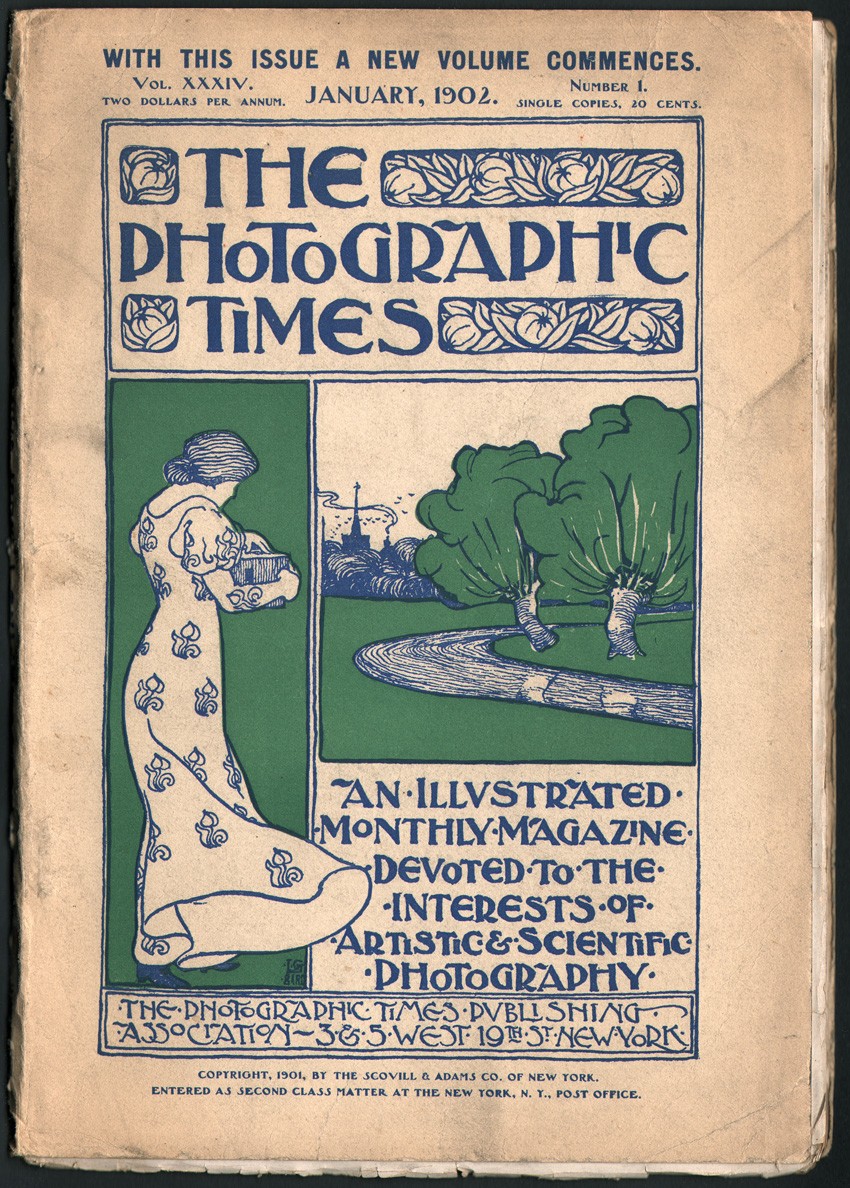 1902: A new cover design was introduced for The Photographic Times beginning with this issue in January, 1902. English artist Lennox G. Bird, who went by the professional moniker Curlew, (a playful association with his last name) had entered and won the Photographic Times silver medal competition the previous year. This design was used through at least January, 1903. Cover dimensions: 25.2 x 17.5 cm Cover: PhotoSeed Archive
1902: A new cover design was introduced for The Photographic Times beginning with this issue in January, 1902. English artist Lennox G. Bird, who went by the professional moniker Curlew, (a playful association with his last name) had entered and won the Photographic Times silver medal competition the previous year. This design was used through at least January, 1903. Cover dimensions: 25.2 x 17.5 cm Cover: PhotoSeed Archive
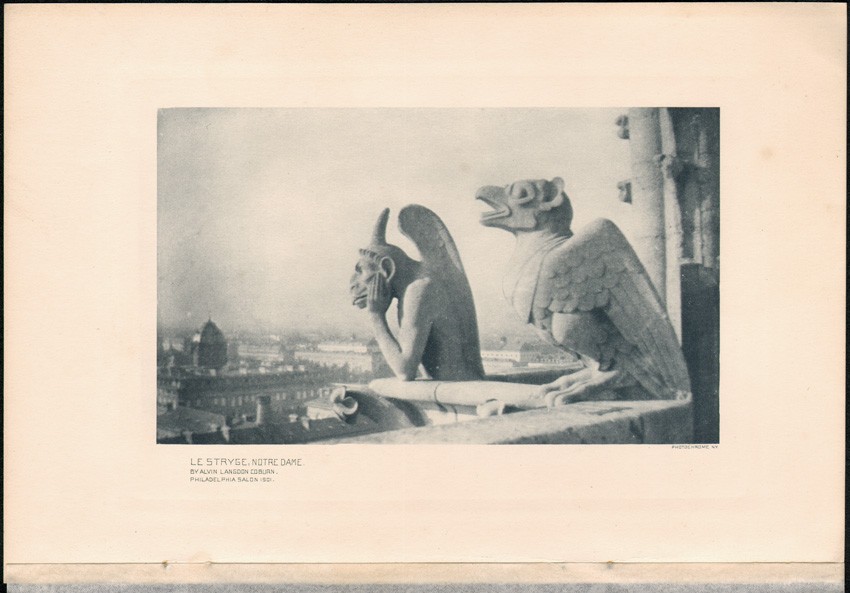 1902: Tissue-protected, hand-pulled photogravures like this example by American and later Welsh photographer Alvin Langdon Coburn (1882-1966) titled "Le Stryge; Notre Dame", continued to be featured in the Photographic Times, albeit in the smaller format beginning with the January, 1901 issue. Printed by the Photochrome Engraving Company of New York City, Coburn's photograph features two gargoyles watching over the city of Paris from a tower parapet of the Cathedral of Notre Dame. The image was inspired by French artist Charles Méryon's (1821-1868) 1853 etching of the gargoyle at center titled Le Stryge. (The Vampire) Plate dimensions: image: 10.0 x 16.4 cm | support:17.1 x 24.9 cm from: PhotoSeed Archive
1902: Tissue-protected, hand-pulled photogravures like this example by American and later Welsh photographer Alvin Langdon Coburn (1882-1966) titled "Le Stryge; Notre Dame", continued to be featured in the Photographic Times, albeit in the smaller format beginning with the January, 1901 issue. Printed by the Photochrome Engraving Company of New York City, Coburn's photograph features two gargoyles watching over the city of Paris from a tower parapet of the Cathedral of Notre Dame. The image was inspired by French artist Charles Méryon's (1821-1868) 1853 etching of the gargoyle at center titled Le Stryge. (The Vampire) Plate dimensions: image: 10.0 x 16.4 cm | support:17.1 x 24.9 cm from: PhotoSeed Archive
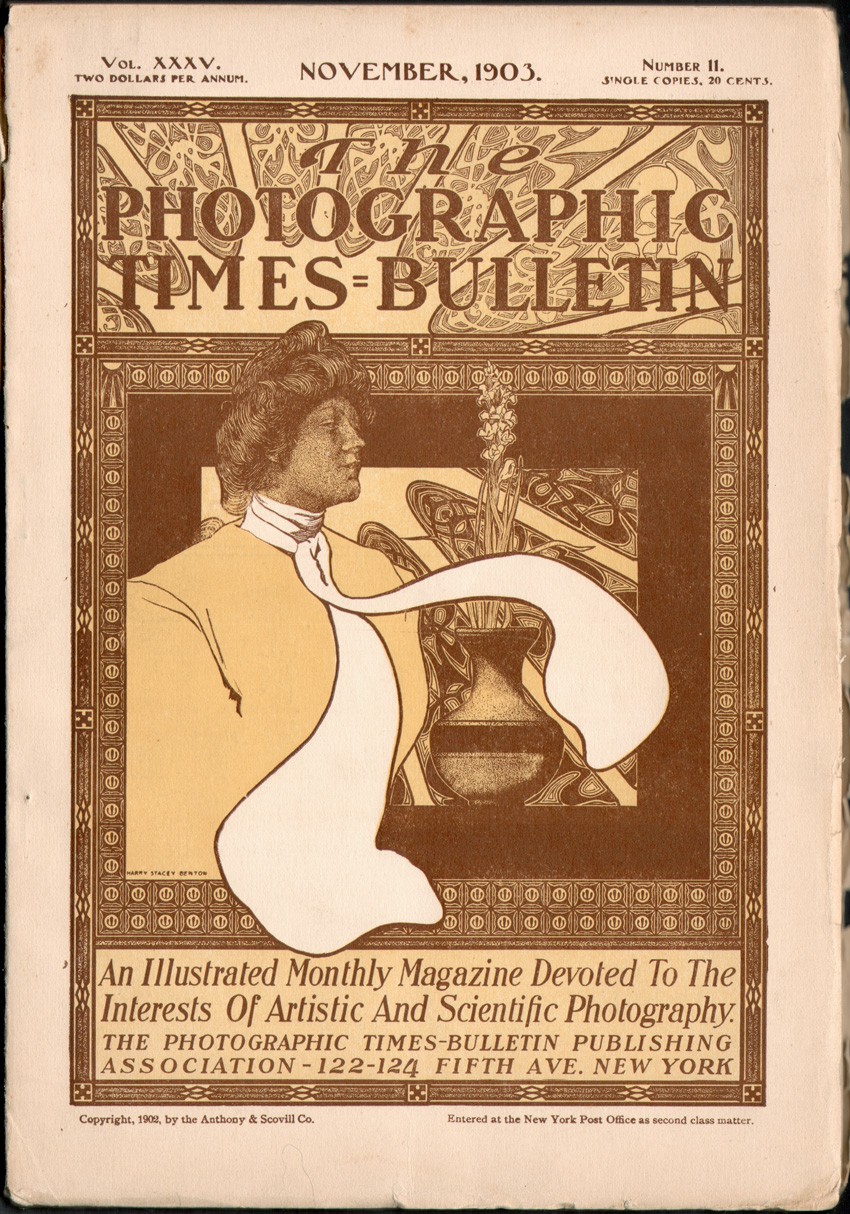 1902-1904: Beginning with the April, 1902 issue, the Photographic Times was renamed The Photographic Times-Bulletin, a combining of the Photographic Times and Anthony’s Photographic Bulletin, itself a result of the blockbuster December, 1901 business deal in which Scovill & Adams joined forces with the E. & H. T. Anthony & Company in order to fight off the mighty Kodak. Lennox G. Bird's cover design from 1902 carried over to the new publication until at least January, 1903, when this design by Chicago illustrator Harry Stacey Benton (b. 1876 or 1878) was used, most likely with the February issue. This was the final cover design for the Times-Bulletin which ceased publication under this name after the December, 1904 issue-reverting back to The Photographic Times in 1905. The wood-engraved, Art-Nouveau portrait of a woman with vase of flowers is set within an elaborate ornamental frame and printed in two colors. Cover dimensions: 25.2 x 17.5 cm. From: PhotoSeed Archive
1902-1904: Beginning with the April, 1902 issue, the Photographic Times was renamed The Photographic Times-Bulletin, a combining of the Photographic Times and Anthony’s Photographic Bulletin, itself a result of the blockbuster December, 1901 business deal in which Scovill & Adams joined forces with the E. & H. T. Anthony & Company in order to fight off the mighty Kodak. Lennox G. Bird's cover design from 1902 carried over to the new publication until at least January, 1903, when this design by Chicago illustrator Harry Stacey Benton (b. 1876 or 1878) was used, most likely with the February issue. This was the final cover design for the Times-Bulletin which ceased publication under this name after the December, 1904 issue-reverting back to The Photographic Times in 1905. The wood-engraved, Art-Nouveau portrait of a woman with vase of flowers is set within an elaborate ornamental frame and printed in two colors. Cover dimensions: 25.2 x 17.5 cm. From: PhotoSeed Archive
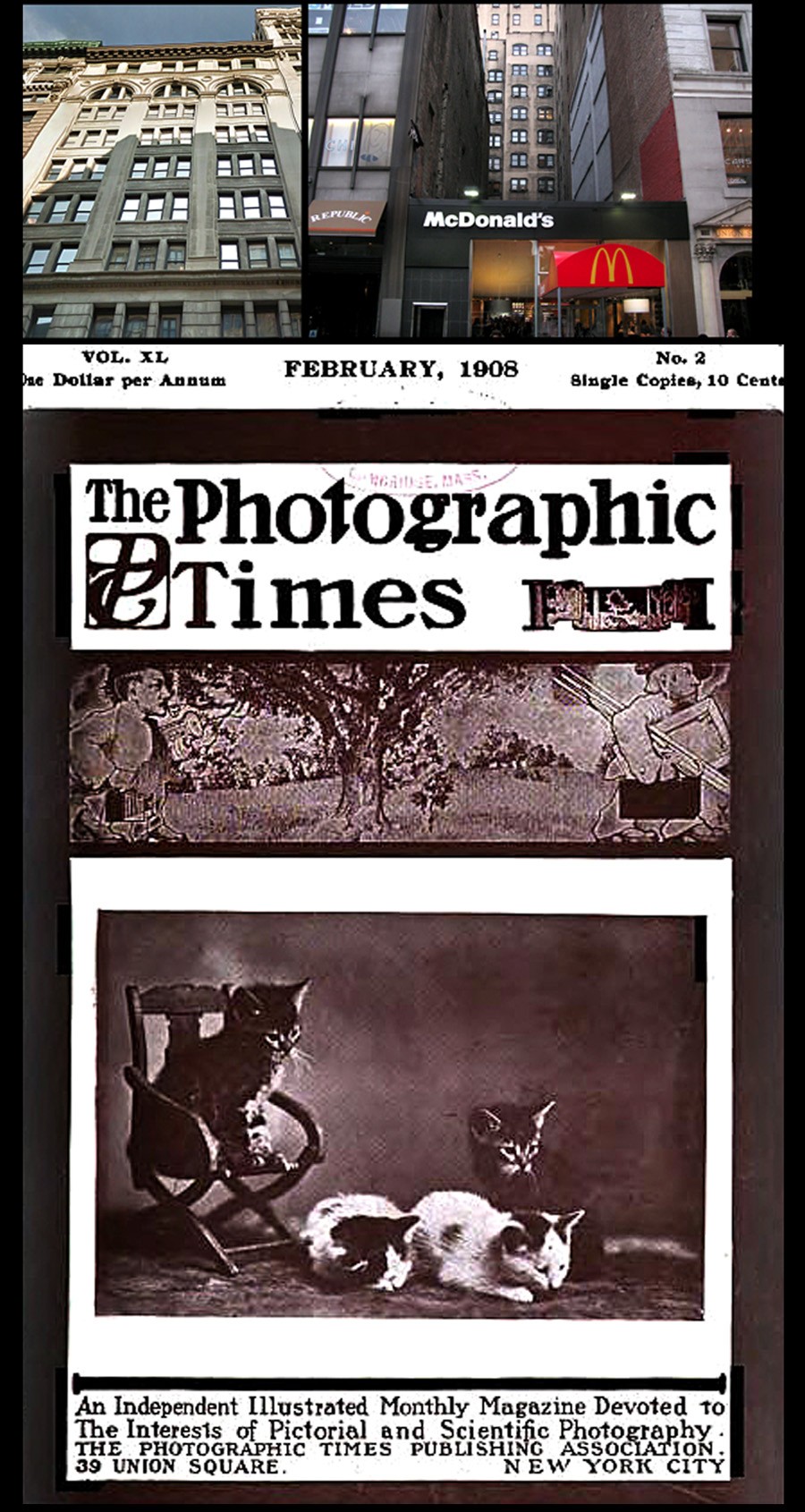 1902-1903 | 1904 | 1904-1908: Three address and two ownership changes took place for the Times-Bulletin and Photographic Times between 1902-1908. Upper left photo: from 1902-1903, the Times-Bulletin was published from this ornate building at 122-124 Fifth Ave.; the home of the combined firm of the Anthony & Scovill Company. By April of 1904, Lincoln Adams had bought out Anthony & Scovill's controlling interest in the journal, retaining the journal's name through the end of the year and moving the offices to Styles & Cash Printers at 75-77 Eighth Ave., a company he was president of. (this building no longer stands and is now occupied by an ornate bank building now turned into luxury condos) Upper right photo: from December, 1904 through 1908, the renamed Photographic Times (January, 1905) was published in a building that also no longer stands at 39 Union Square West, now the location of a McDonald's restaurant. Bottom cover: This is a representative cover of the Times from the Union Square years. Now priced at 10 cents, or a dollar a year, it featured a whimsical caricature of a photographer with camera in hand following an artist who holds his canvas and easel in pursuit of the next great vista anchored below the journal masthead. The February, 1908 cover art featured a large halftone photograph of decidedly "light" subject matter: a grouping of kittens. Reflecting this decidedly saccharine mass-market appeal, the Times guiding principal at bottom of cover also had changed to: "An Independent Illustrated Monthly Magazine Devoted to The Interests of Pictorial and Scientific Photography." Photo credits: Anthony & Scovill: Google Street View; Union Square: David Spencer/PhotoSeed Archive, cover: HathiTrust
1902-1903 | 1904 | 1904-1908: Three address and two ownership changes took place for the Times-Bulletin and Photographic Times between 1902-1908. Upper left photo: from 1902-1903, the Times-Bulletin was published from this ornate building at 122-124 Fifth Ave.; the home of the combined firm of the Anthony & Scovill Company. By April of 1904, Lincoln Adams had bought out Anthony & Scovill's controlling interest in the journal, retaining the journal's name through the end of the year and moving the offices to Styles & Cash Printers at 75-77 Eighth Ave., a company he was president of. (this building no longer stands and is now occupied by an ornate bank building now turned into luxury condos) Upper right photo: from December, 1904 through 1908, the renamed Photographic Times (January, 1905) was published in a building that also no longer stands at 39 Union Square West, now the location of a McDonald's restaurant. Bottom cover: This is a representative cover of the Times from the Union Square years. Now priced at 10 cents, or a dollar a year, it featured a whimsical caricature of a photographer with camera in hand following an artist who holds his canvas and easel in pursuit of the next great vista anchored below the journal masthead. The February, 1908 cover art featured a large halftone photograph of decidedly "light" subject matter: a grouping of kittens. Reflecting this decidedly saccharine mass-market appeal, the Times guiding principal at bottom of cover also had changed to: "An Independent Illustrated Monthly Magazine Devoted to The Interests of Pictorial and Scientific Photography." Photo credits: Anthony & Scovill: Google Street View; Union Square: David Spencer/PhotoSeed Archive, cover: HathiTrust
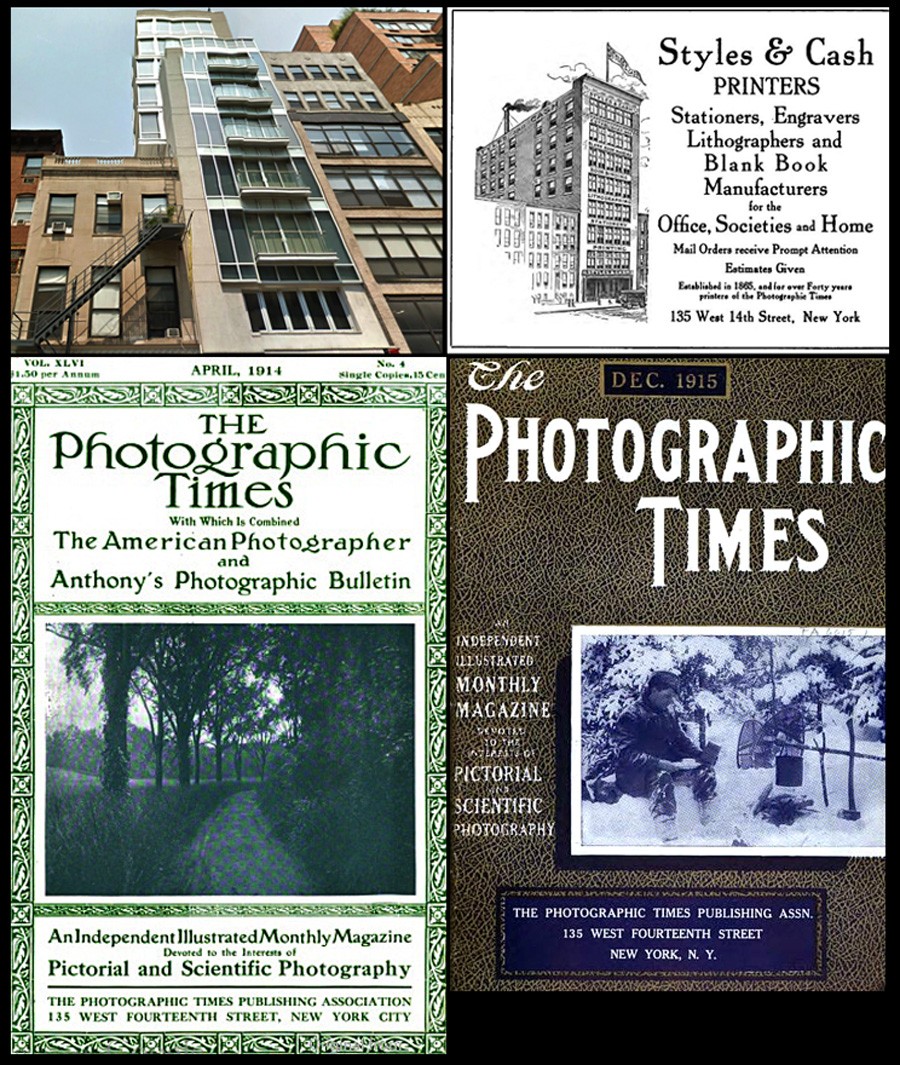 1909-1915: Under The Photographic Times Publishing Association, the Times was edited and published the final six years from this building at 135 West 14th street at top left: a ten-story building erected in 1906 by architect Charles Birge for the printing firm Styles & Cash. Since remade (2004) into condos on the upper floors with a hair salon at street level, a December, 1915 advertisement in the Times for the company is at top right. Two other cover design changes for the journal took place during this period. At lower left is the issue from April, 1914 and at lower right, the final cover for the December, 1915 issue. The Styles & Cash firm was in operation in New York from 1865-1920. Photo credits: Styles & Cash: Google Street View; ad & covers: HathiTrust
1909-1915: Under The Photographic Times Publishing Association, the Times was edited and published the final six years from this building at 135 West 14th street at top left: a ten-story building erected in 1906 by architect Charles Birge for the printing firm Styles & Cash. Since remade (2004) into condos on the upper floors with a hair salon at street level, a December, 1915 advertisement in the Times for the company is at top right. Two other cover design changes for the journal took place during this period. At lower left is the issue from April, 1914 and at lower right, the final cover for the December, 1915 issue. The Styles & Cash firm was in operation in New York from 1865-1920. Photo credits: Styles & Cash: Google Street View; ad & covers: HathiTrust
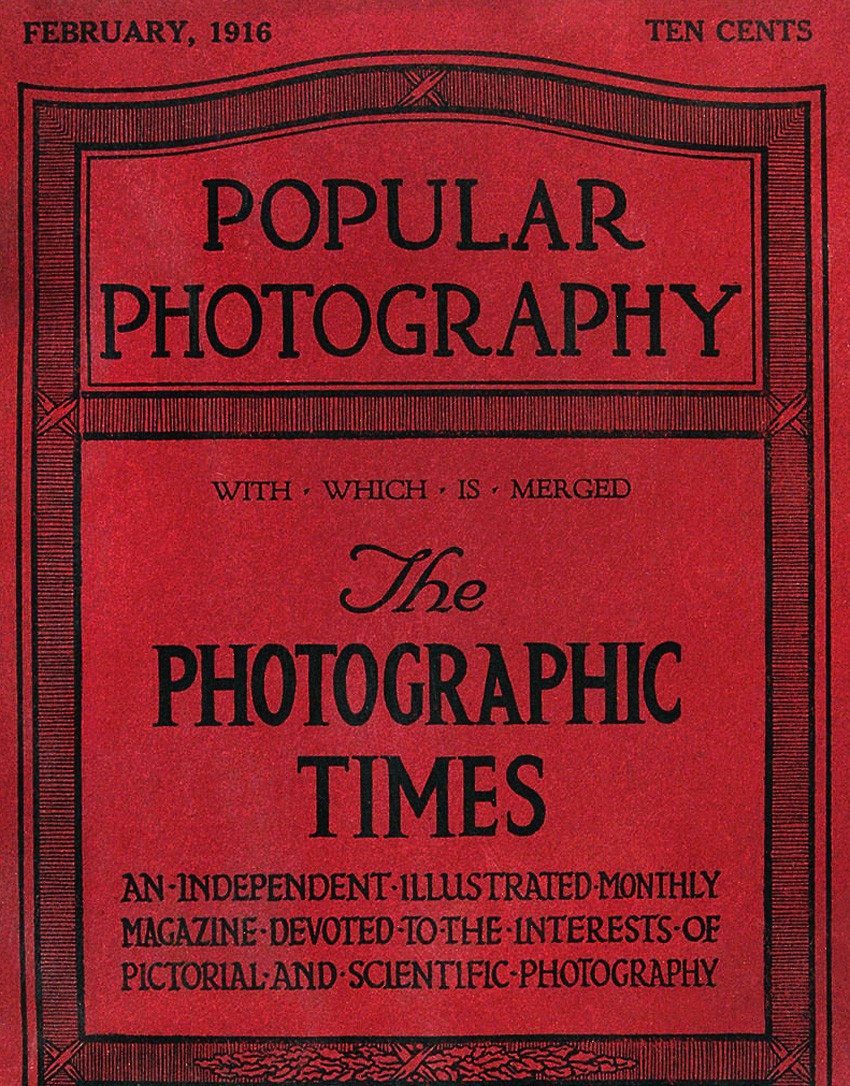 1916: With Which Is Merged: Beginning with the January, 1916 issue, the Times masthead was gone for good: absorbed into Popular Photography, a new journal published in Boston since October, 1912. Edited by Frank Roy Fraprie, W. I. Lincoln Adams was retained as an associate editor, although it is doubtful he had much of a hand with its affairs. Cover detail: February, 1916: Ebay
1916: With Which Is Merged: Beginning with the January, 1916 issue, the Times masthead was gone for good: absorbed into Popular Photography, a new journal published in Boston since October, 1912. Edited by Frank Roy Fraprie, W. I. Lincoln Adams was retained as an associate editor, although it is doubtful he had much of a hand with its affairs. Cover detail: February, 1916: Ebay
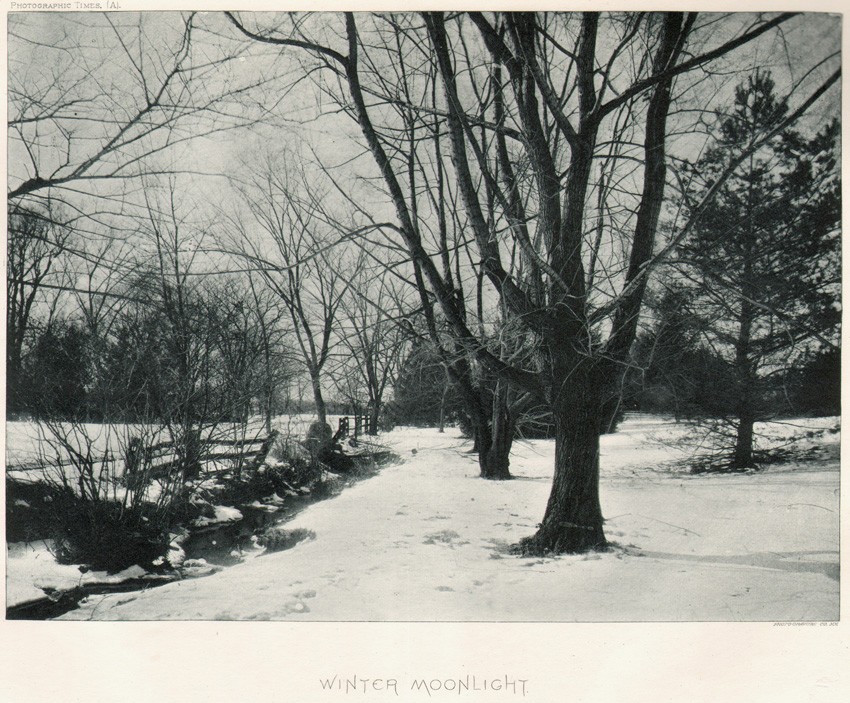 The Photographic Times was a labor of love for a father and son. Washington Irving Adams had the spark and drive to get the journal up and running beginning in 1870 and son W. I. Lincoln Adams dutifully took over the reigns of not only the journal but the Scovill & Adams firm upon his father's passing. In my view, the legacy they left in the form of the journal is invaluable, with their efforts along with many others giving enjoyment and continuing instruction on the art and science of photography from 1871-1915 we should continue to appreciate and investigate. This landscape study "Winter Moonlight" by Lincoln Adams was taken around 1885 and published in the Times in 1890. It is not especially memorable in my view, but does contain the kernel of adventure all photography has: "Let the landscape loving photographer of this city and neighborhood take a ramble with his camera" the Times copywriter (possibly Adams himself) declared as inspiration taken from the scene of this snow-blanketed wooded glade. Continuing the thought, "Mr. Adams is always eager to conduct a party, large or small, to the beautiful haunts about his picturesque home." As a young photographer myself, this was just the type of place I took my own camera to in search of what photography could accomplish and mean while learning most about my own self. My hunch is Adams own tramps in places like this shaped his thinking and outlook as well. Image: 14.4 x 19.7 cm | support: 20.5 x 28.7 cm. : photogravure in The Photographic Times, February 7, 1890 | issue No. 438: From: PhotoSeed Archive
The Photographic Times was a labor of love for a father and son. Washington Irving Adams had the spark and drive to get the journal up and running beginning in 1870 and son W. I. Lincoln Adams dutifully took over the reigns of not only the journal but the Scovill & Adams firm upon his father's passing. In my view, the legacy they left in the form of the journal is invaluable, with their efforts along with many others giving enjoyment and continuing instruction on the art and science of photography from 1871-1915 we should continue to appreciate and investigate. This landscape study "Winter Moonlight" by Lincoln Adams was taken around 1885 and published in the Times in 1890. It is not especially memorable in my view, but does contain the kernel of adventure all photography has: "Let the landscape loving photographer of this city and neighborhood take a ramble with his camera" the Times copywriter (possibly Adams himself) declared as inspiration taken from the scene of this snow-blanketed wooded glade. Continuing the thought, "Mr. Adams is always eager to conduct a party, large or small, to the beautiful haunts about his picturesque home." As a young photographer myself, this was just the type of place I took my own camera to in search of what photography could accomplish and mean while learning most about my own self. My hunch is Adams own tramps in places like this shaped his thinking and outlook as well. Image: 14.4 x 19.7 cm | support: 20.5 x 28.7 cm. : photogravure in The Photographic Times, February 7, 1890 | issue No. 438: From: PhotoSeed Archive
Dream Girls
Posted August 2012 in New Additions
My weekend adventure-mysterious airport layovers aside-celebrated my daughter’s graduation from college. And no, this certainly is not her photograph, for it most likely depicts a younger high school graduate instead, wearing a circa 1895 garment that is a true work of diplomatic fashion—incomparable to the disposable, one-zipper frock my daughter wore for her modern ceremony of pomp and circumstance.
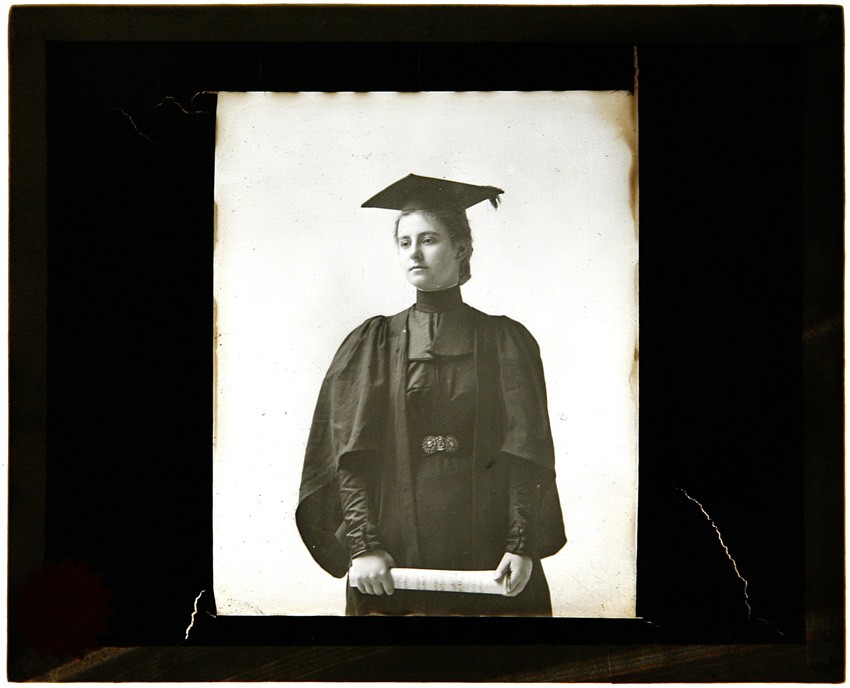 James Lawrence Breese: United States: vintage lantern slide ca. 1895-1905: "Woman graduate holding Diploma": support glass: 3.25 x 4.0": window opening: 6.4 x 5.2 cm: from: PhotoSeed Archive
James Lawrence Breese: United States: vintage lantern slide ca. 1895-1905: "Woman graduate holding Diploma": support glass: 3.25 x 4.0": window opening: 6.4 x 5.2 cm: from: PhotoSeed Archive
For those in the know, the journey of higher education is never easy or predictable, for student or parent. But to those students everywhere earning the right to walk with their class on graduation day, the commencement is rightful icing on the cake and a glorious stepping stone to the next chapter. In the case of this late 19th century lantern slide portrait seen here, the fact that women in the United States had not yet earned the legal right to vote does not diminish this graduate’s pride in her accomplishment, as evidenced by her strong comportment.
The ceremony I attended featured all the usual bullet points, with the comic relief of microphone malfunction segueing to the esteemed retired professor remarking on how the school’s newly inaugurated football prowess in the late 1940’s trumped the fact it had previously been known as an institution of higher learning for women only. Applause all around of course, but I rather like the fact the school has foundational women bones.
With my own parents supporting my dream of becoming a photographer long ago, my now fatherly advice to an alumni daughter stressed the practical, but also advised exploring the road less traveled with the idea of embracing failure in order to learn.
Tripod not Optional
Posted July 2012 in New Additions, Photographic Preservation
Commemorative events in world history recorded in the early years of photography were entirely documentary, with the brutal results being a kind of topographical portraiture not often appreciated by modern viewers, at least for the efforts expended on behalf of their makers.
 Detail: Frances V. Stevens: American: 1893: "Gondolier passing Statue of the Republic" in Grand Basin of the World's Columbian Exposition held in Chicago. In background can be seen Peristyle from Liberal Arts building which overlooked Lake Michigan: vintage mounted gelatin-silver photograph: 10.8 x 9.5 cm: PhotoSeed Archive
Detail: Frances V. Stevens: American: 1893: "Gondolier passing Statue of the Republic" in Grand Basin of the World's Columbian Exposition held in Chicago. In background can be seen Peristyle from Liberal Arts building which overlooked Lake Michigan: vintage mounted gelatin-silver photograph: 10.8 x 9.5 cm: PhotoSeed Archive
Industrial and world expositions come to mind: the 1867 Exposition Universelle in Paris and 1876 Centennial International Exhibition in Philadelphia being some of the better known. Before the very early 1880’s, when the dry plate came into wide use, photographers attending these expositions would need a portable darkroom and chemicals mixed on the spot for the coating of glass plates- quickly inserted into the back of their tripod-mounted cameras in order to make an exposure. Major hurdles typically not ventured by the average photographer.
Enter the 1893 World’s Columbian Exposition held in Chicago, and the wide availability by then of dry plates and roll film for the teeming photographic masses. 1892 marked the 400th anniversary of Christopher Columbus’s arrival in North America and its’ commemoration from May to October the following year attracted over 27 million people from around the world. But so-called “serious” photography practiced there, along with capitalistic motive by those in charge, conspired against the dedicated photographer attending. With the exception of practical solutions for photographers in the form of railings, pedestals or fixed objects, only one attendee was allowed the luxury of lugging a camera tripod around the 600+ acre fairgrounds, Charles Dudley Arnold, (1844-1927) designated the World’s Fair Official Photographer.
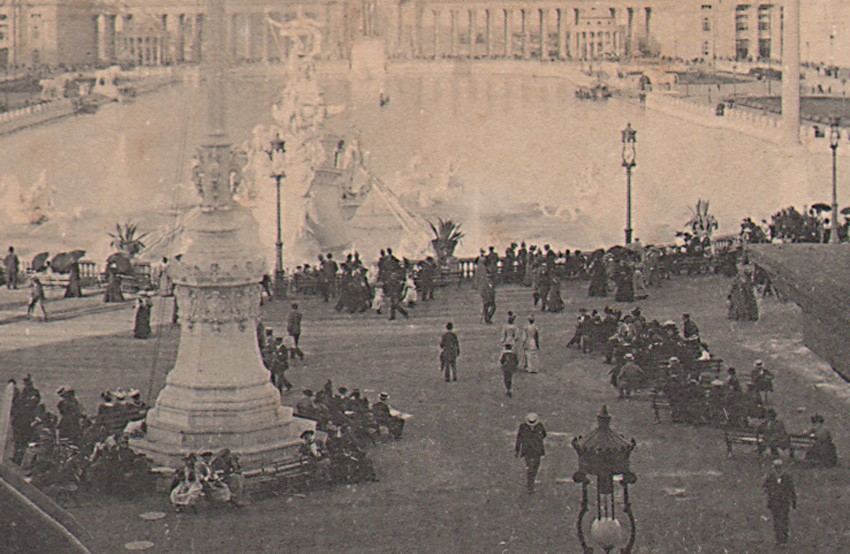 Detail: Frances V. Stevens: American: 1893: "People Congregating in Court of Honor" on east side of Administration Building overlooking the Grand Basin at World's Columbian Exposition held in Chicago. vintage mounted gelatin-silver photograph: 9.2 x 12.1 cm: PhotoSeed Archive
Detail: Frances V. Stevens: American: 1893: "People Congregating in Court of Honor" on east side of Administration Building overlooking the Grand Basin at World's Columbian Exposition held in Chicago. vintage mounted gelatin-silver photograph: 9.2 x 12.1 cm: PhotoSeed Archive
Tripods aside, the biggest obstacle was financial, as a daily permit was required. After shelling out .50¢ for daily admission, someone intent on photographing the grandeur of the Chicago fair needed to pay an additional $2.00 for the privilege, almost $50.00 in today’s currency.
“Of course, any one who pays the required $2 can obtain a permit to photograph in the World’s Fair grounds with a four-by-five (or smaller) camera, and without a tripod” ,
the Photographic Times helpfully informed its readership on September 22, 1893.
One person who had no problems with the price of a daily photographic permit was Miss Frances V. Stevens of New York City. A world traveler, she was an active and exhibiting member of the New York Camera Club as early as 1891 according to The American Amateur Photographer. Her society credentials were equally impressive, with the New York Times mentioning her in a July, 1890 article along with Louise Whitfield Carnegie, the spouse of Andrew Carnegie, one of the world’s richest people: “Among the New York ladies who are amateur photographers are Mrs. Andrew Carnegie, … Miss Frances V. Stevens” it stated.
 Detail: Frances V. Stevens: American: 1893: at right: "Entrance to the Fisheries Arcade" (Henry Ives Cobb): a bullfrog can be seen peering out from a riot of frogs on the set of columns at right on the grounds of World's Columbian Exposition held in Chicago. This ornamental hand-work was made from staff, composed of plaster, cement, and jute fibers. Vintage mounted gelatin-silver photograph: 10.5 x 9.8 cm: PhotoSeed Archive
Detail: Frances V. Stevens: American: 1893: at right: "Entrance to the Fisheries Arcade" (Henry Ives Cobb): a bullfrog can be seen peering out from a riot of frogs on the set of columns at right on the grounds of World's Columbian Exposition held in Chicago. This ornamental hand-work was made from staff, composed of plaster, cement, and jute fibers. Vintage mounted gelatin-silver photograph: 10.5 x 9.8 cm: PhotoSeed Archive
Six surviving examples of photographs taken by Frances Stevens, all signed by her and taken at the 1893 World’s fair, have now been added to the site. Believed to be contact-prints from cut or reduced 4 x 5” negatives, they had originally been individually framed. Improper storage has also taken a toll on the work and they each exhibit a large amount of surface staining-but not enough to preclude their artistic and historical importance from being seen here.
Even in the reduced format, the Stevens prints are chock full of nuance, and I’ve taken the liberty of showing details from select examples to illustrate this post. In many ways, her less scripted results by means of the smaller hand camera are extremely valuable documents-certainly in regards to artistic consideration-but equal in different ways to many of those captured by one of Charles Arnold’s 11 x 14 inch plate cameras. In consideration of preservation issues and speaking of the wonder of large glass plate negatives in general, a vast secret life waits to be uncovered by historians willing to take the time to save this material. Something crucial and I dare say almost too late for one of humankind’s greatest achievements, her invention of photography.
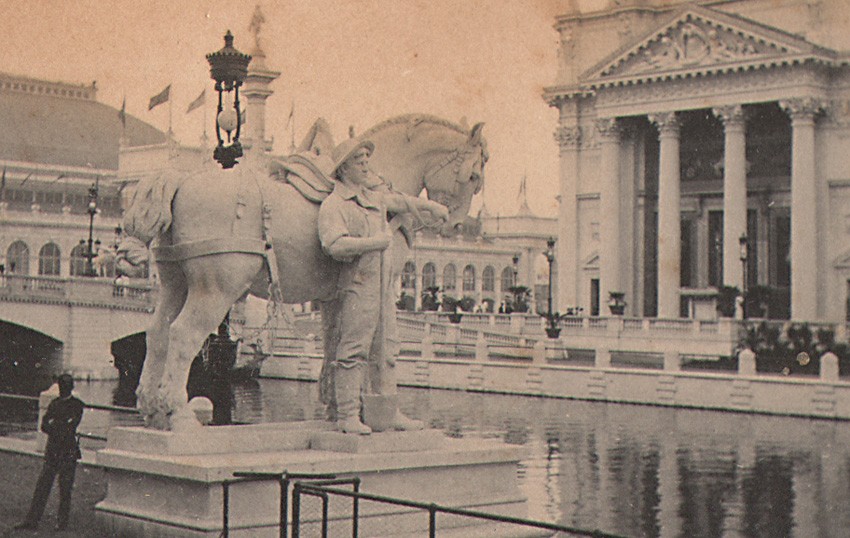 Detail: Frances V. Stevens: American: 1893: "Statue of Industry" by American sculptor Edward Clark Potter (1857-1923): statue overlooks South Basin with part of the Manufactures and Liberal Arts Building seen on left and Agriculture Building at right. vintage mounted gelatin-silver photograph: 9.2 x 11.8 cm: PhotoSeed Archive
Detail: Frances V. Stevens: American: 1893: "Statue of Industry" by American sculptor Edward Clark Potter (1857-1923): statue overlooks South Basin with part of the Manufactures and Liberal Arts Building seen on left and Agriculture Building at right. vintage mounted gelatin-silver photograph: 9.2 x 11.8 cm: PhotoSeed Archive
If one were willing and intrigued by the idea however, photographic archives from newspapers around the world dating to the early 20th century can be a wonderful starting point. For those seeking evidence and inspiration with respect to digital preservation, please check out Springfield Photographs, a site concentrating on the Midwestern American experience from 1929-1935 and most worthy of your attention.
Jump for Joy
Posted July 2012 in PhotoSeed
Yesterday officially marked one year since I launched PhotoSeed.com as a public site and I wanted to thank everyone who has taken the time to visit or who has inadvertently stumbled upon us. To date, this site has had tremendous world-wide reach in its short life, with hundreds of thousands of page views perused by visitors hailing from a total of 163 countries & territories. In addition, PhotoSeed received a Webby, the highest industry award for a website in the Art category during a ceremony in New York City this past May. And who knew we could count a very loyal following from those residing in Vietnam’s Ho Chi Minh City? I’m not a micro-focused person by any means, but the wonders of Google Analytics never cease to amaze.
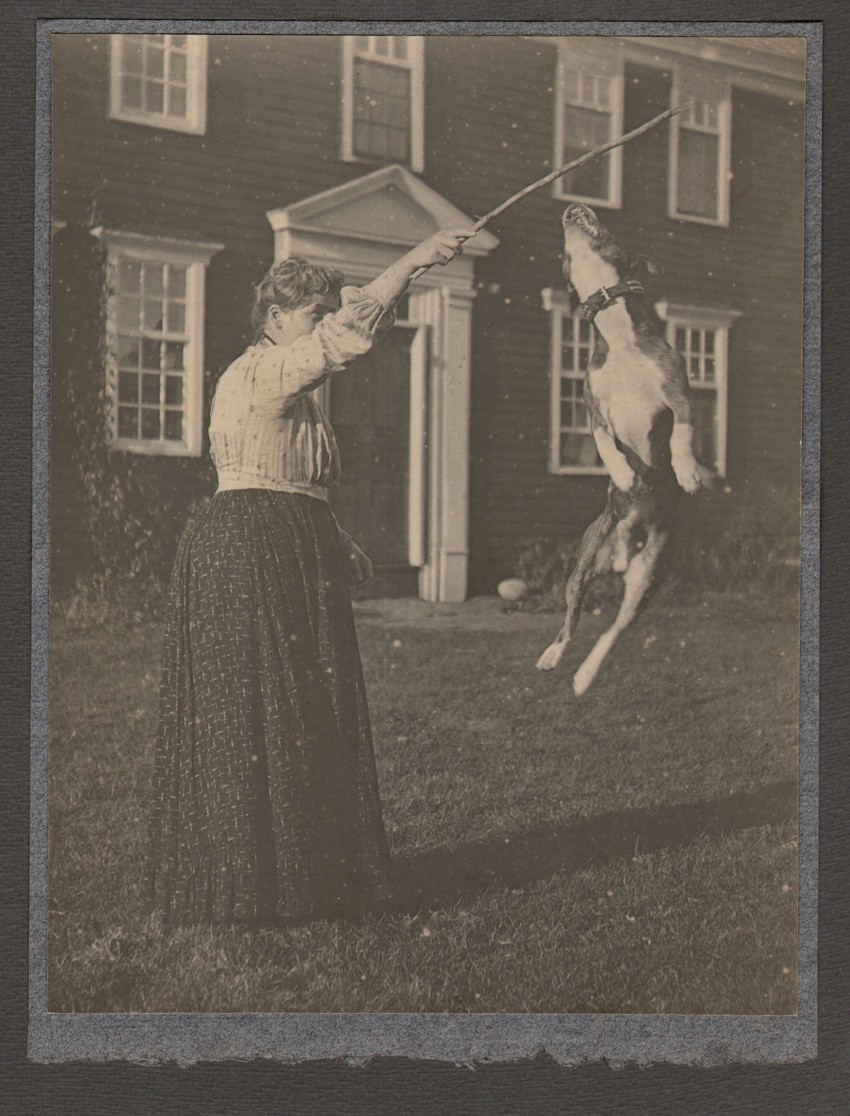 C.M. Whitney, (Chester Moulton) American, b. 1873: "Peter" or "A High Jumper": 1907: vintage gelatin-silver photograph: image: 19.1 x 14.7 cm | primary support: 20.4 x 15.4 cm | secondary support: 30.5 x 25.4 cm : from: PhotoSeed Archive
C.M. Whitney, (Chester Moulton) American, b. 1873: "Peter" or "A High Jumper": 1907: vintage gelatin-silver photograph: image: 19.1 x 14.7 cm | primary support: 20.4 x 15.4 cm | secondary support: 30.5 x 25.4 cm : from: PhotoSeed Archive
My plans and goals for the next year are many. Ultimately, I would like to devote my time to the site full-time, with the means of supporting this dream through a combination of an online sales gallery selling vintage material, licensing agreements, and, perhaps, select archival reproductions for purchase. As always, your suggestions are welcome as I approach this fork in the road, and I sincerely welcome your input and ideas going forward. As my own time allows, it is my intent to continue building on my own evolving scholarship as I assess and then post material from the vintage work making up the PhotoSeed Archive. As I’ve said before, there is every reason to “get it right” the first time, and I don’t see it as a race.
And so it is my honor, delight, and satisfaction to be able to shine light and—hold for this metaphor—let the creative flowers from my photographic brothers and sisters bloom after hiding in the dark far too long. I hope you enjoy the discoveries and continue the journey with us.
-David Spencer
